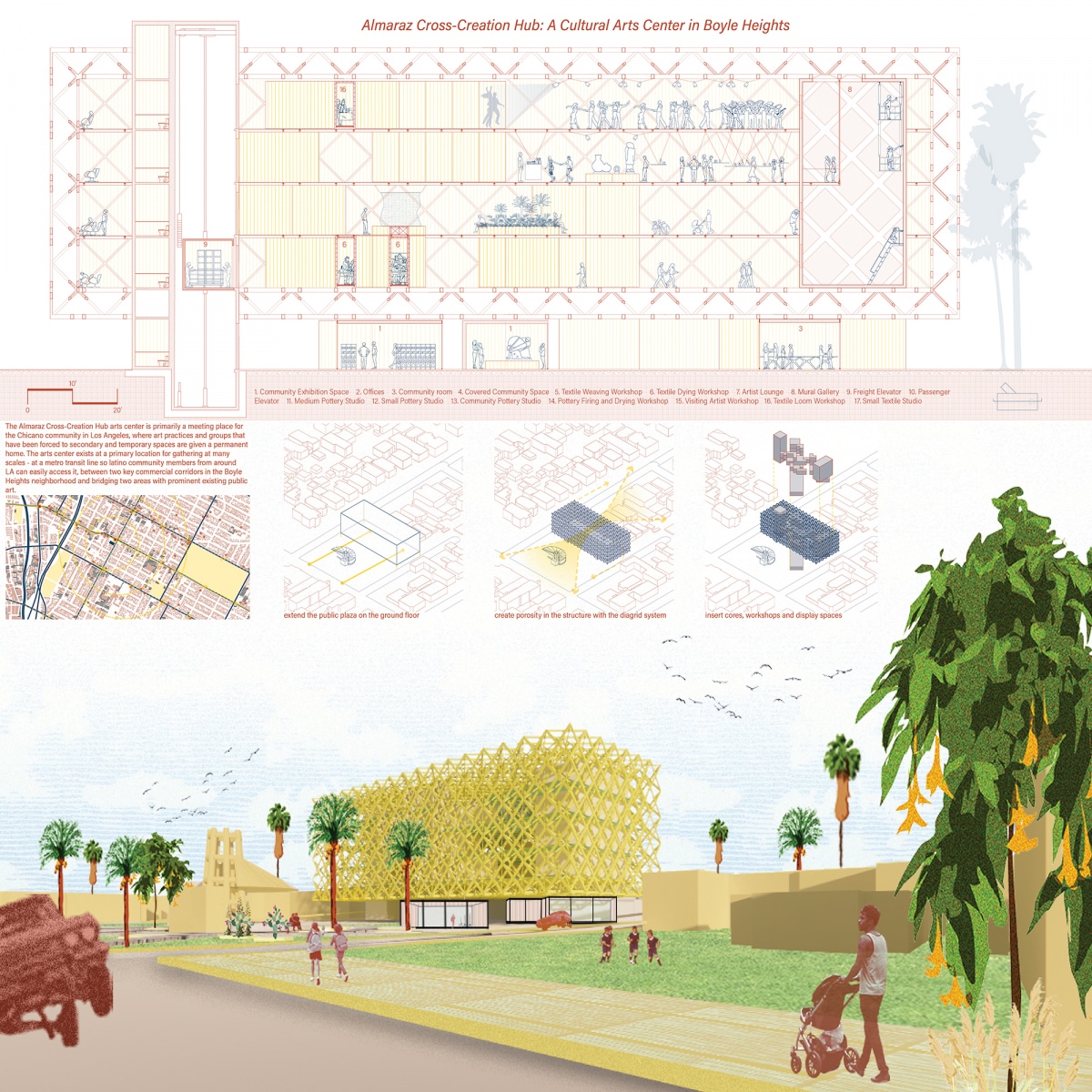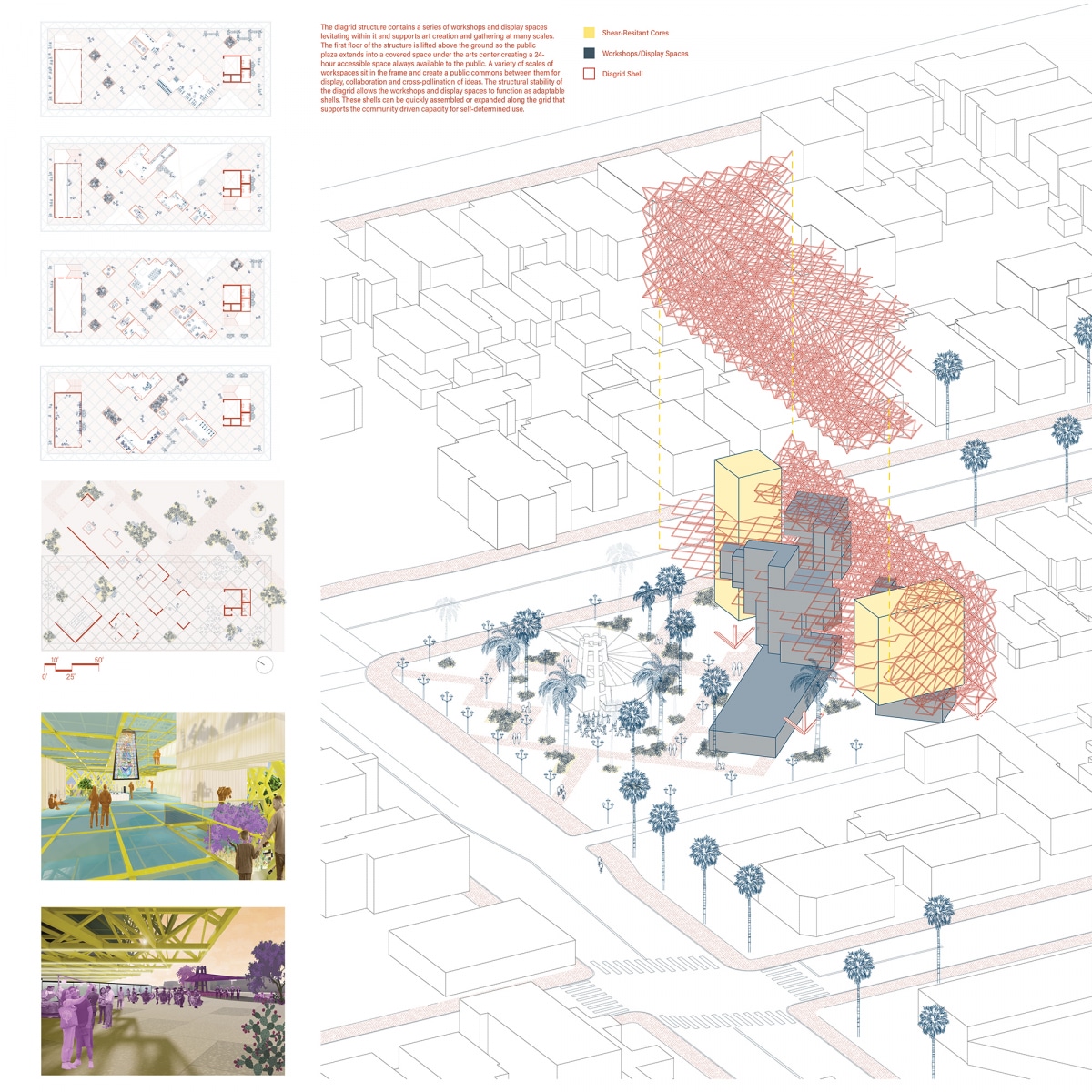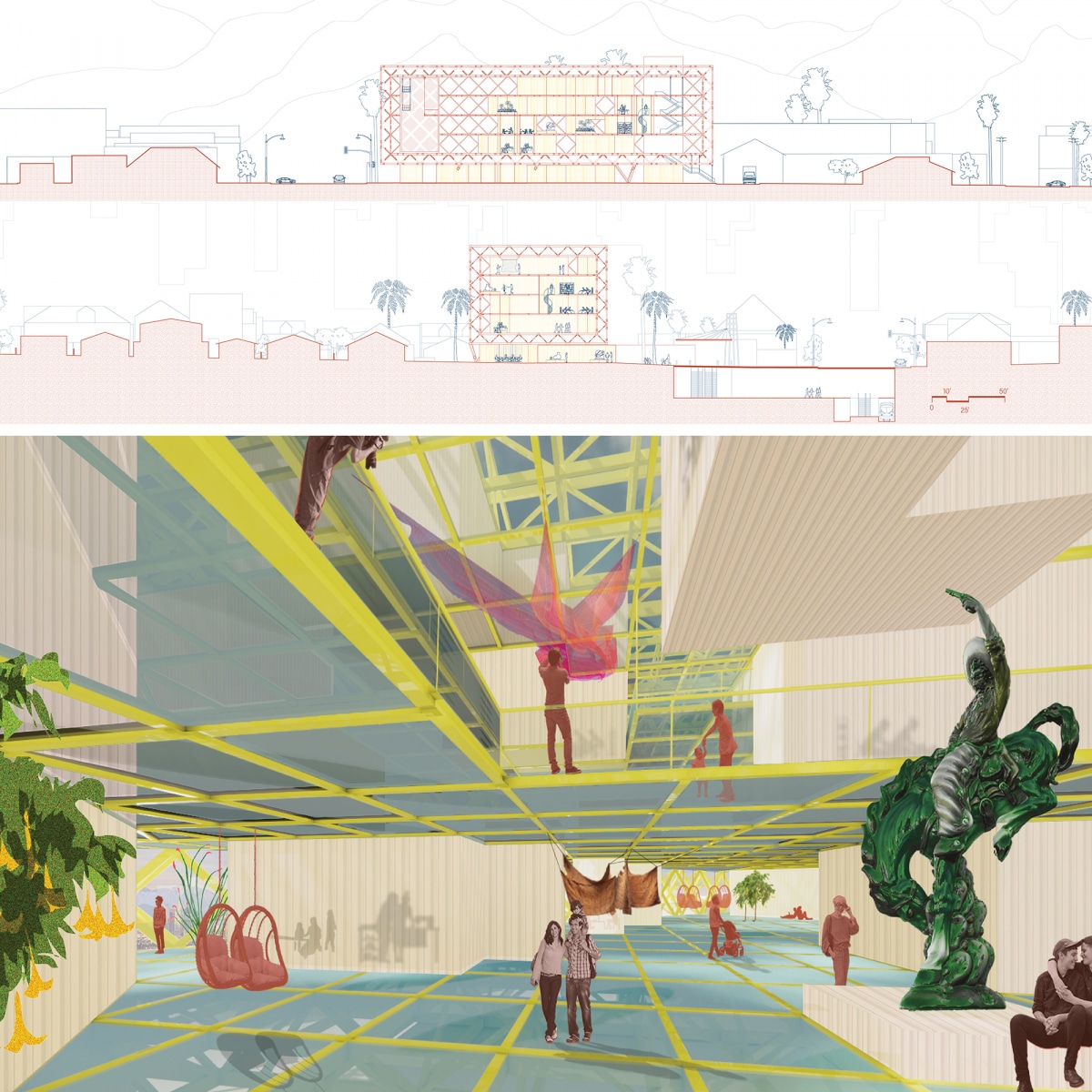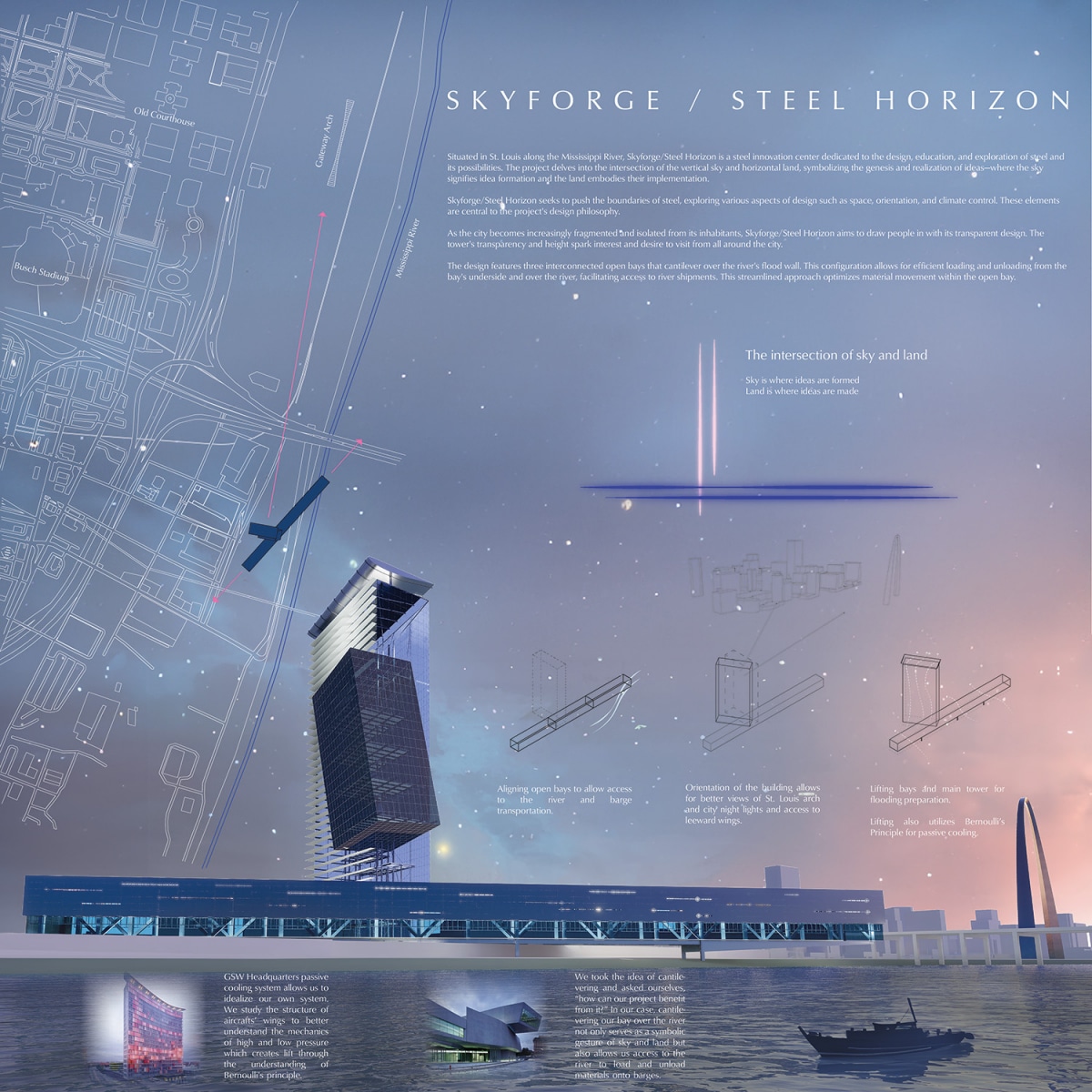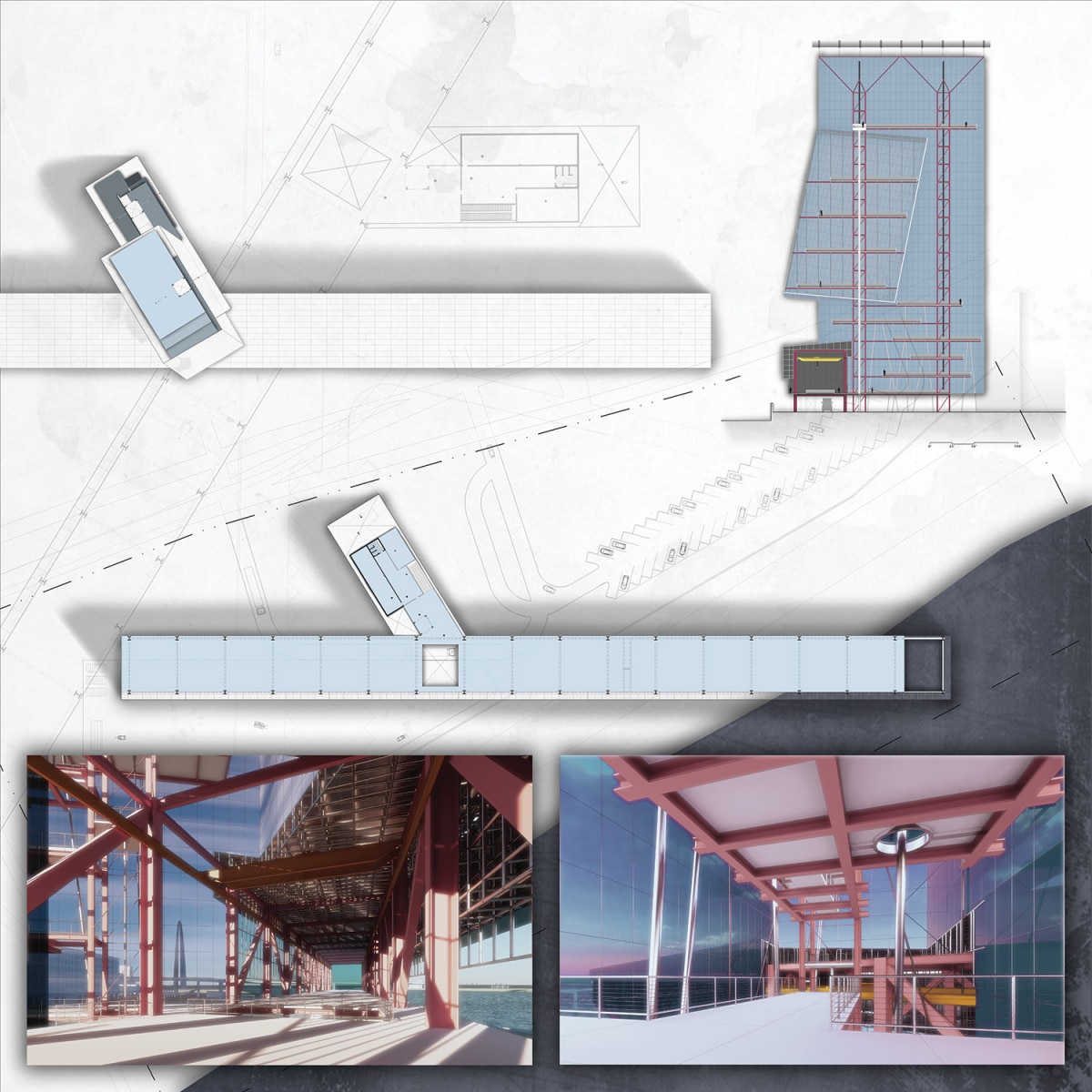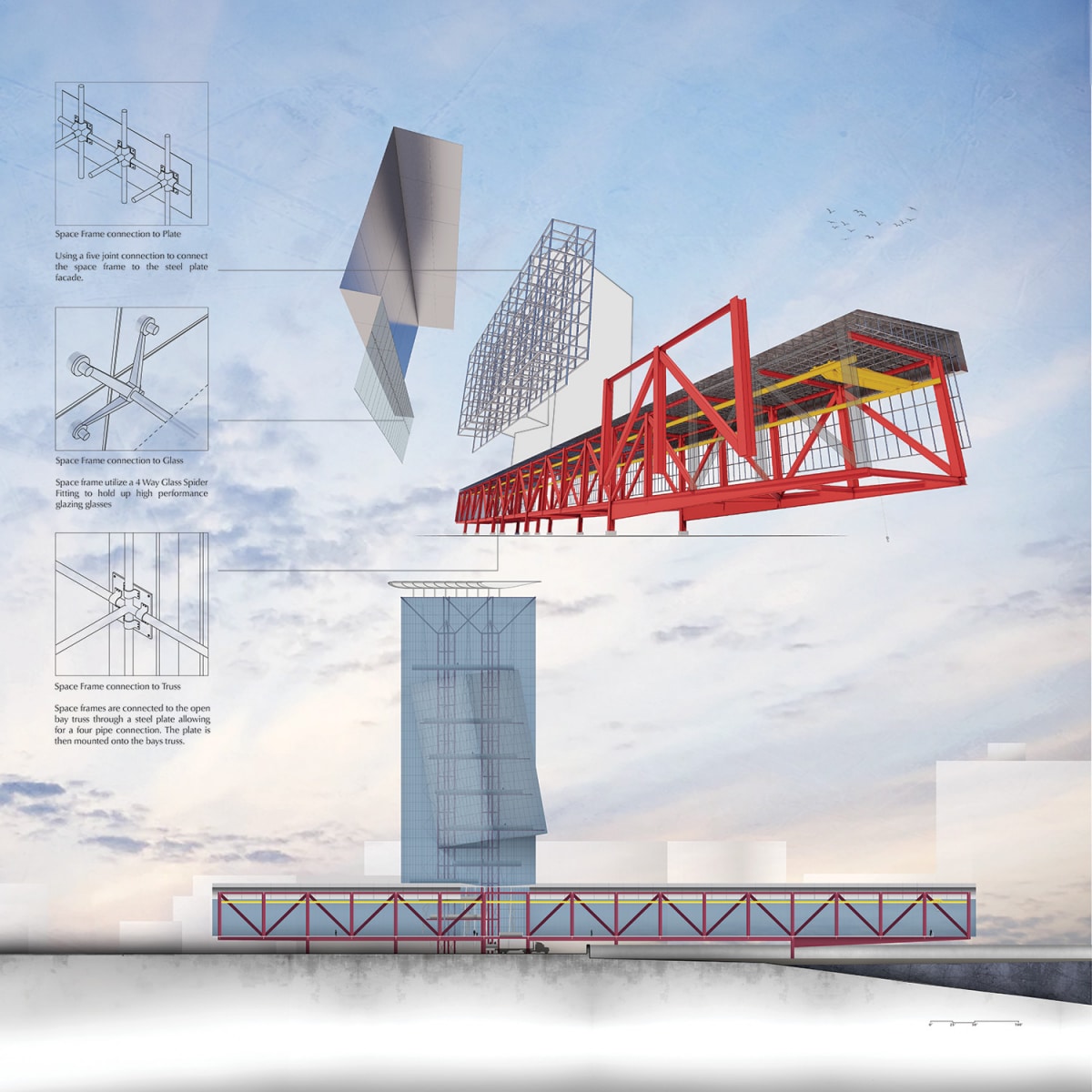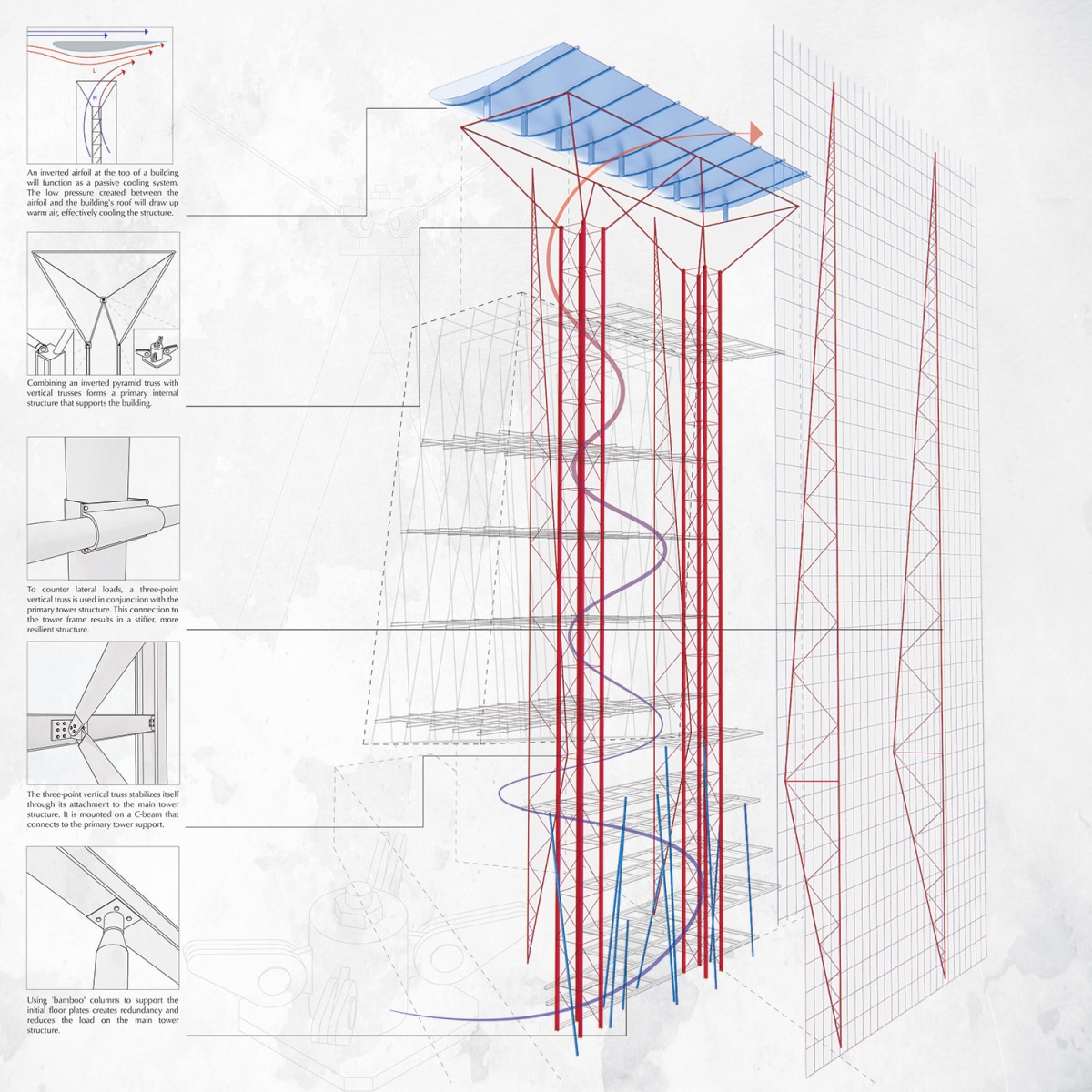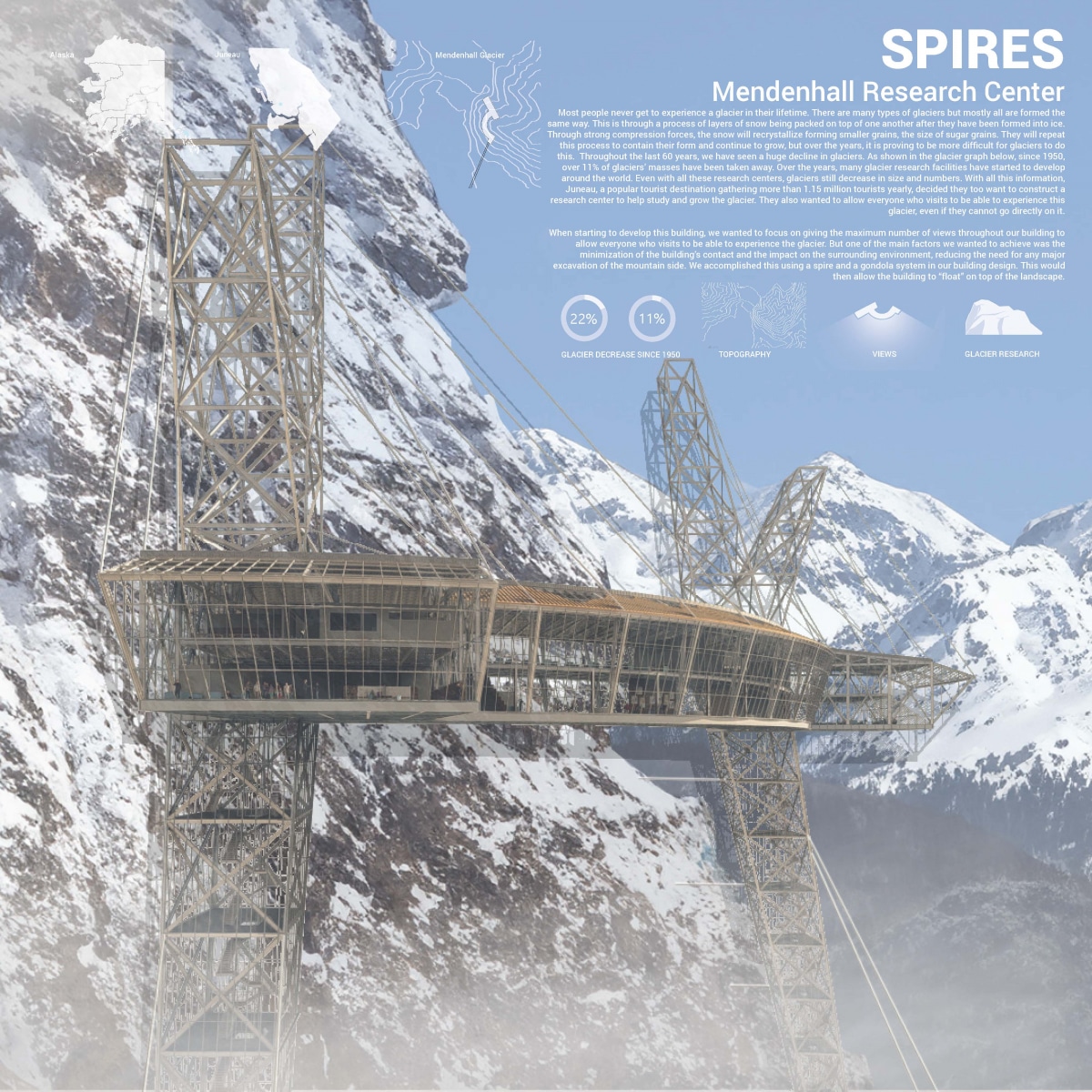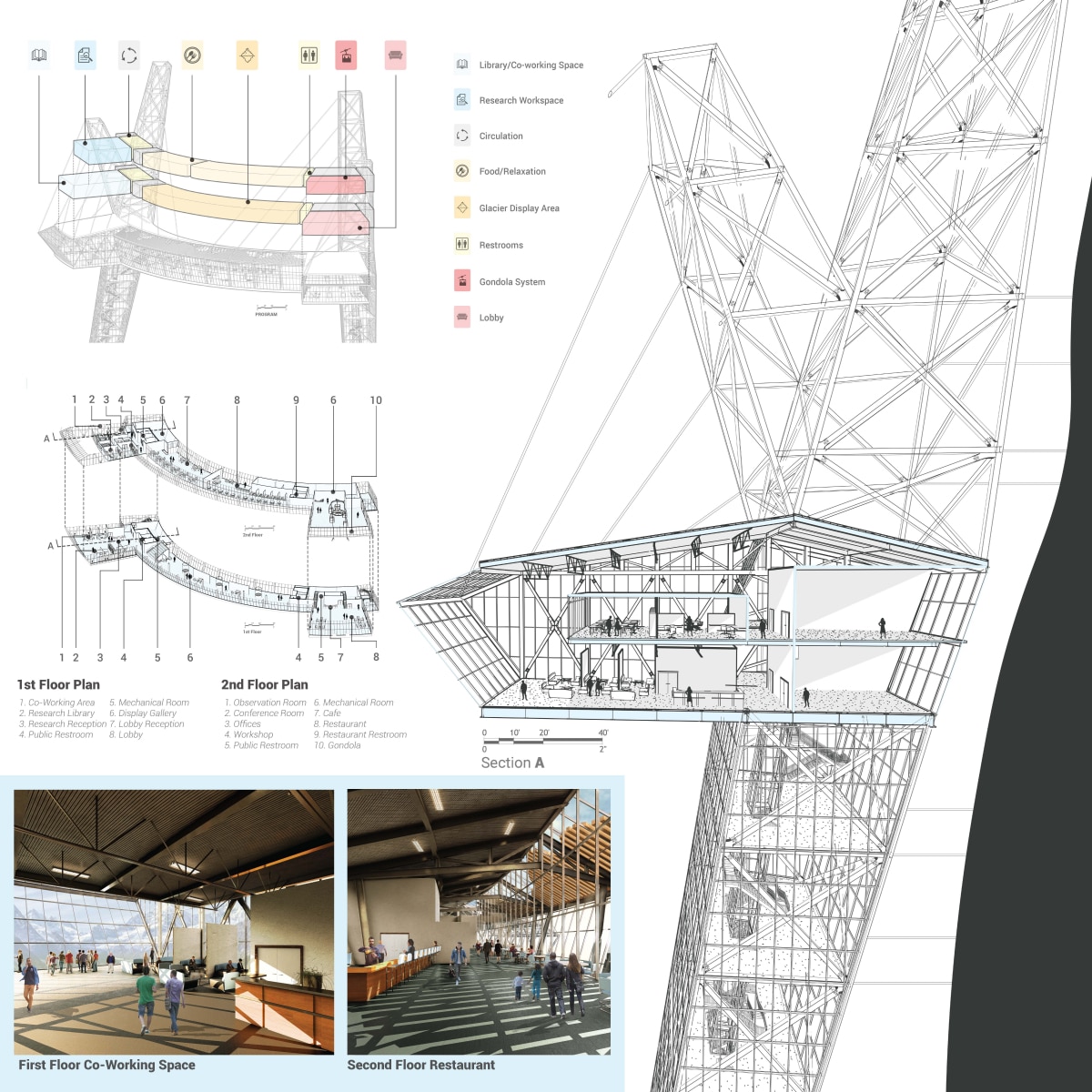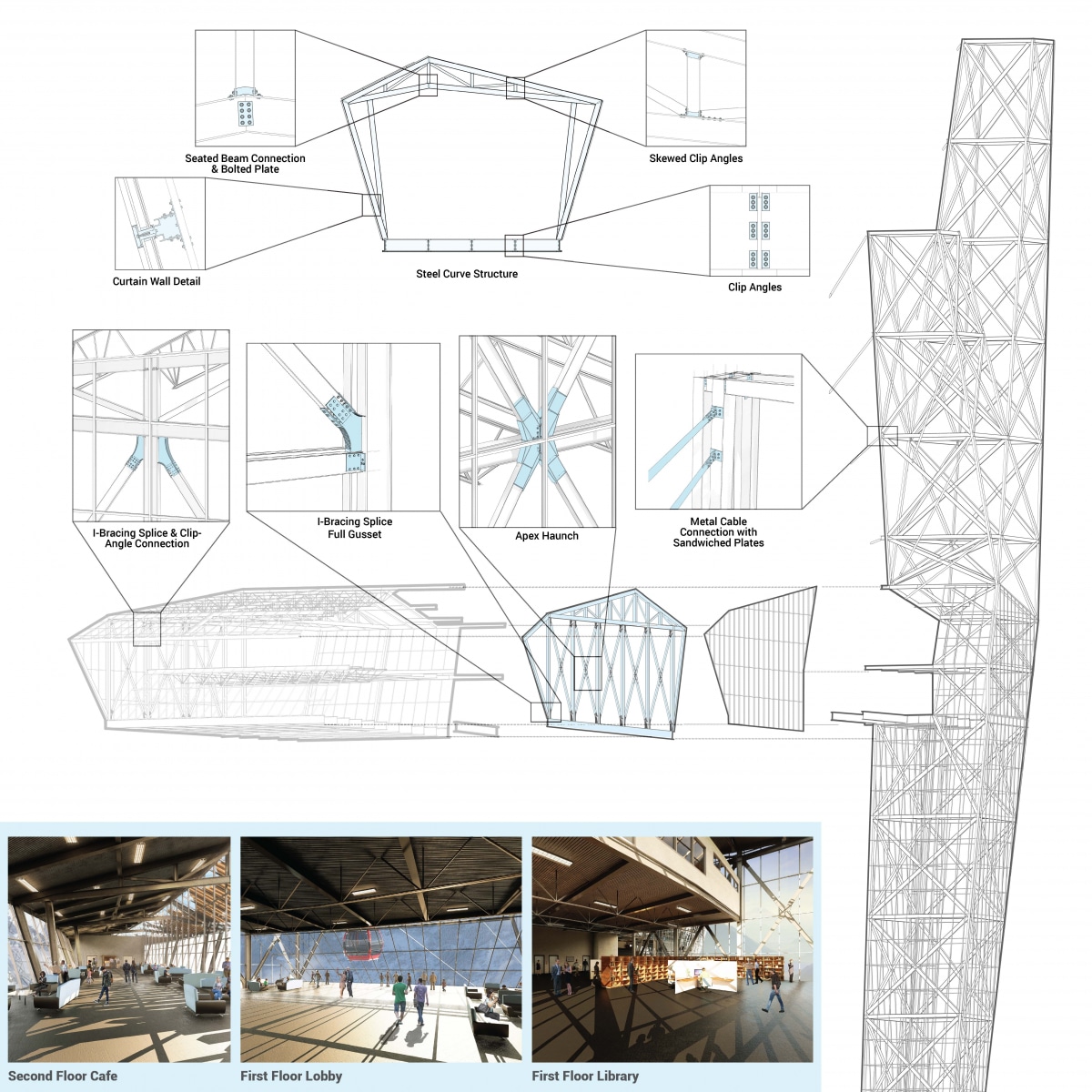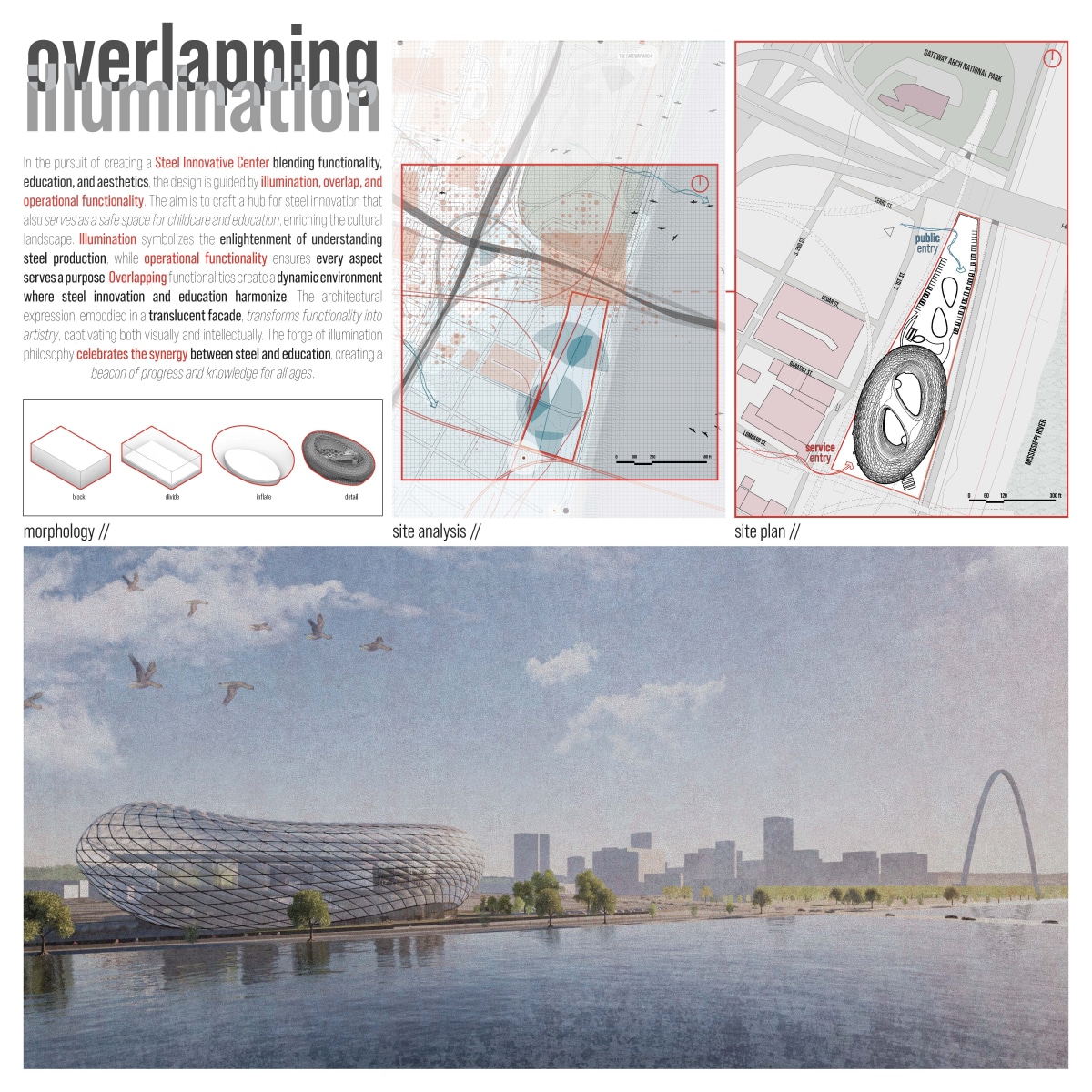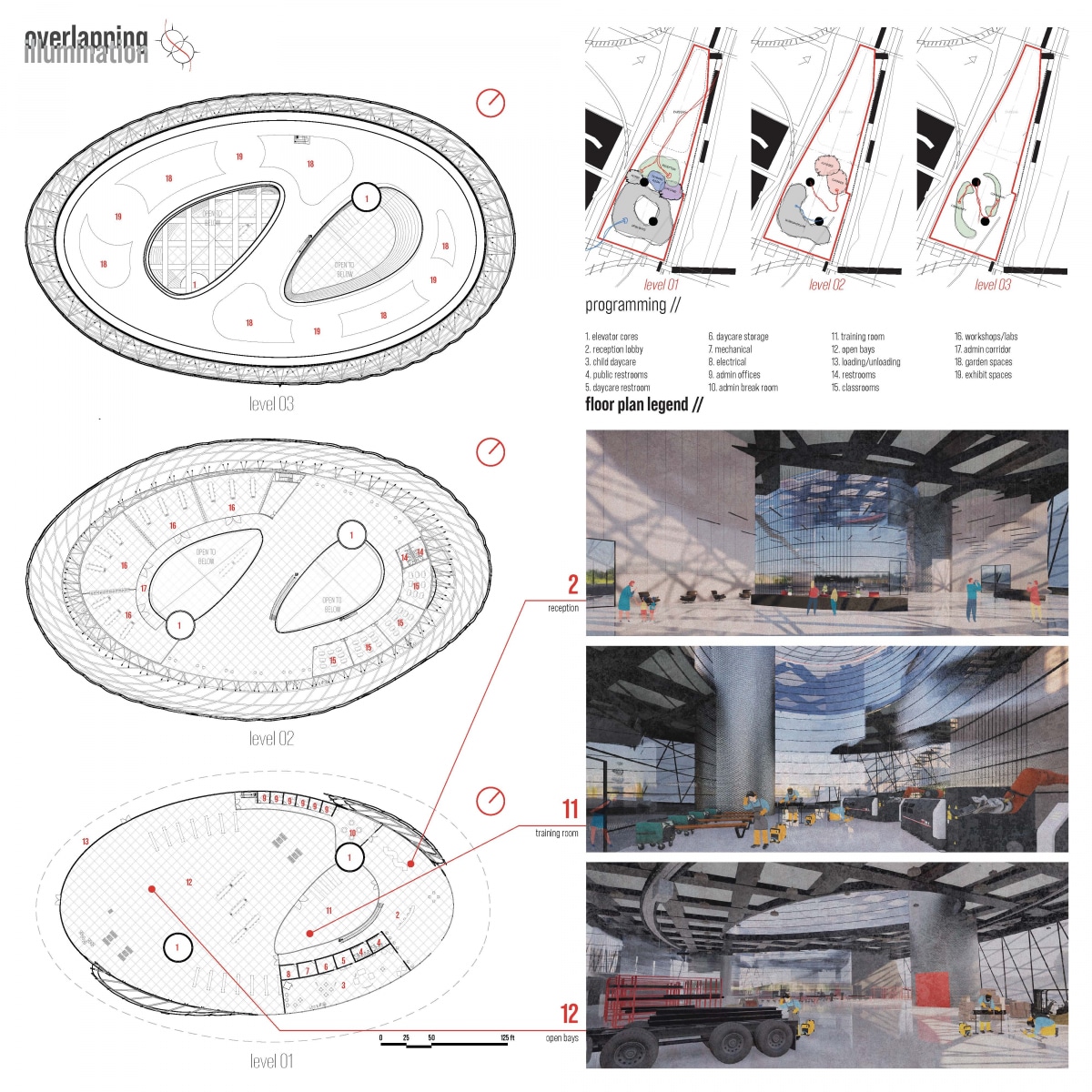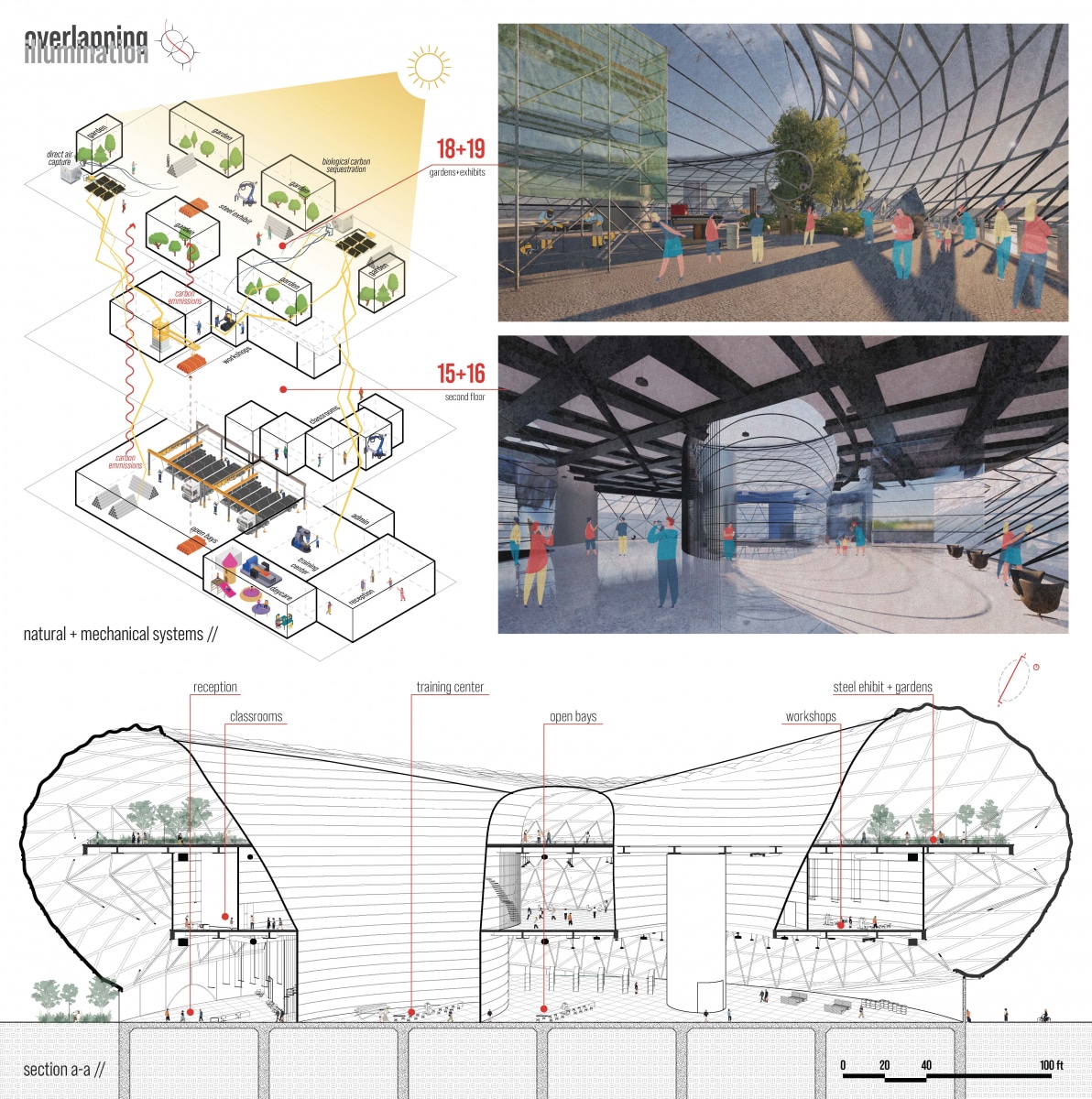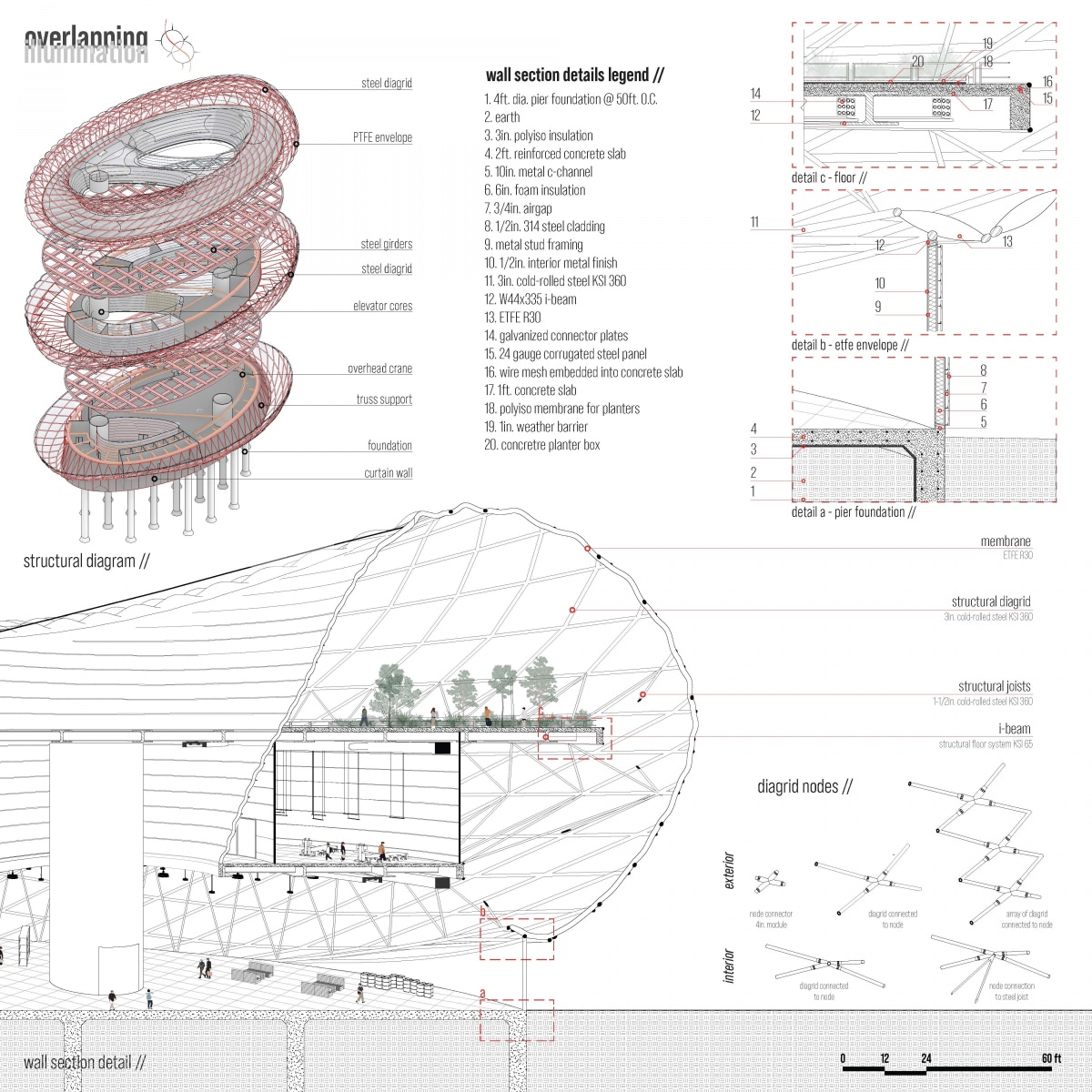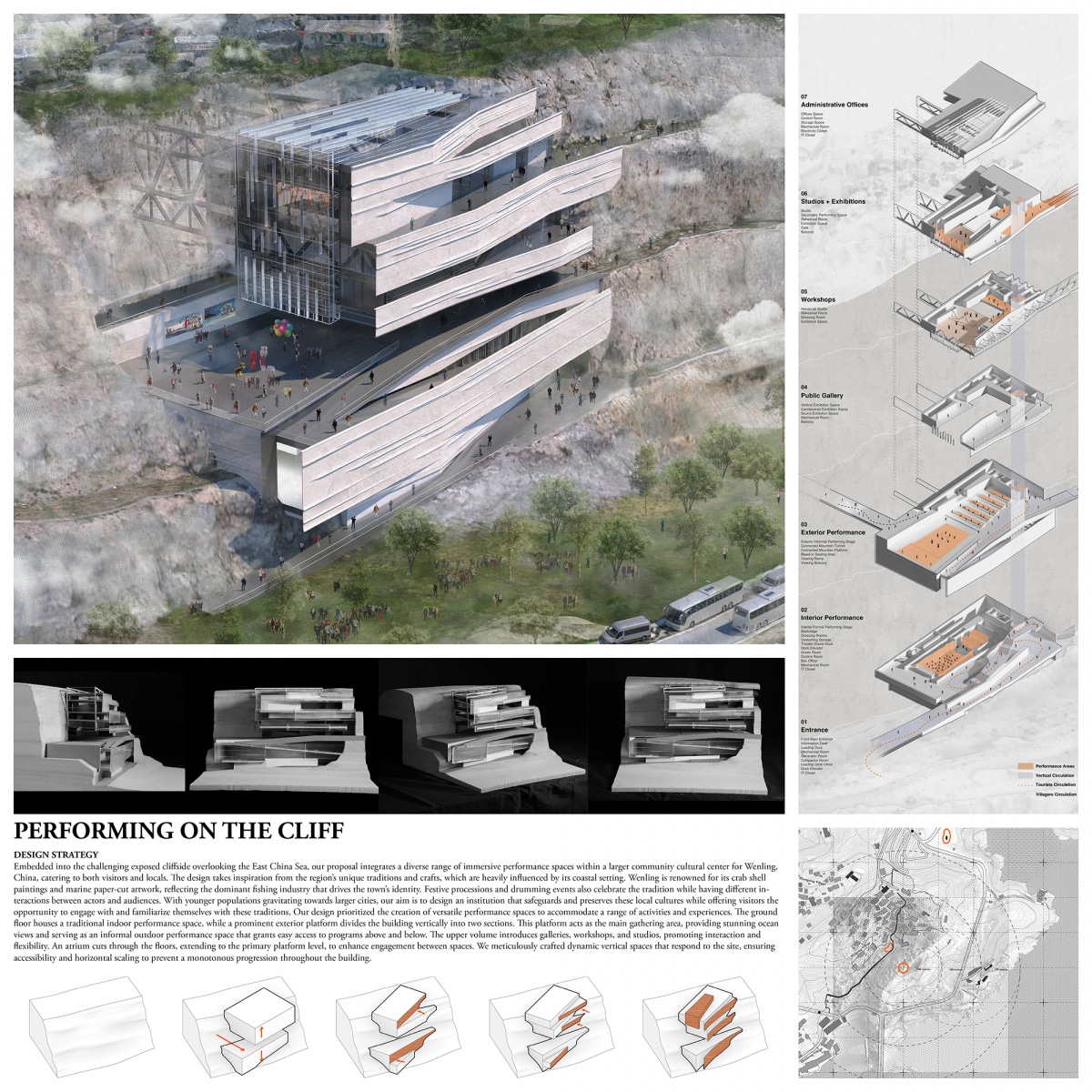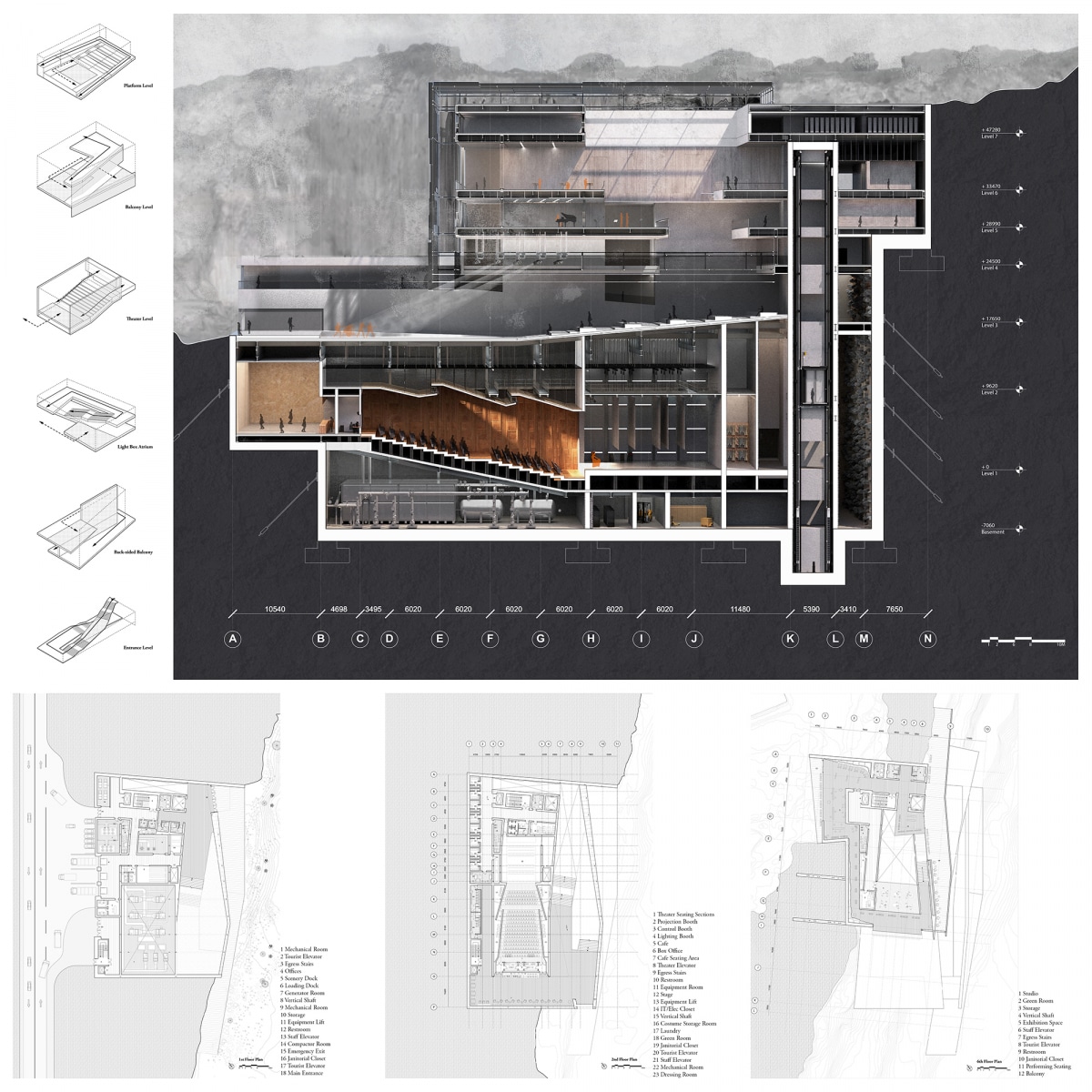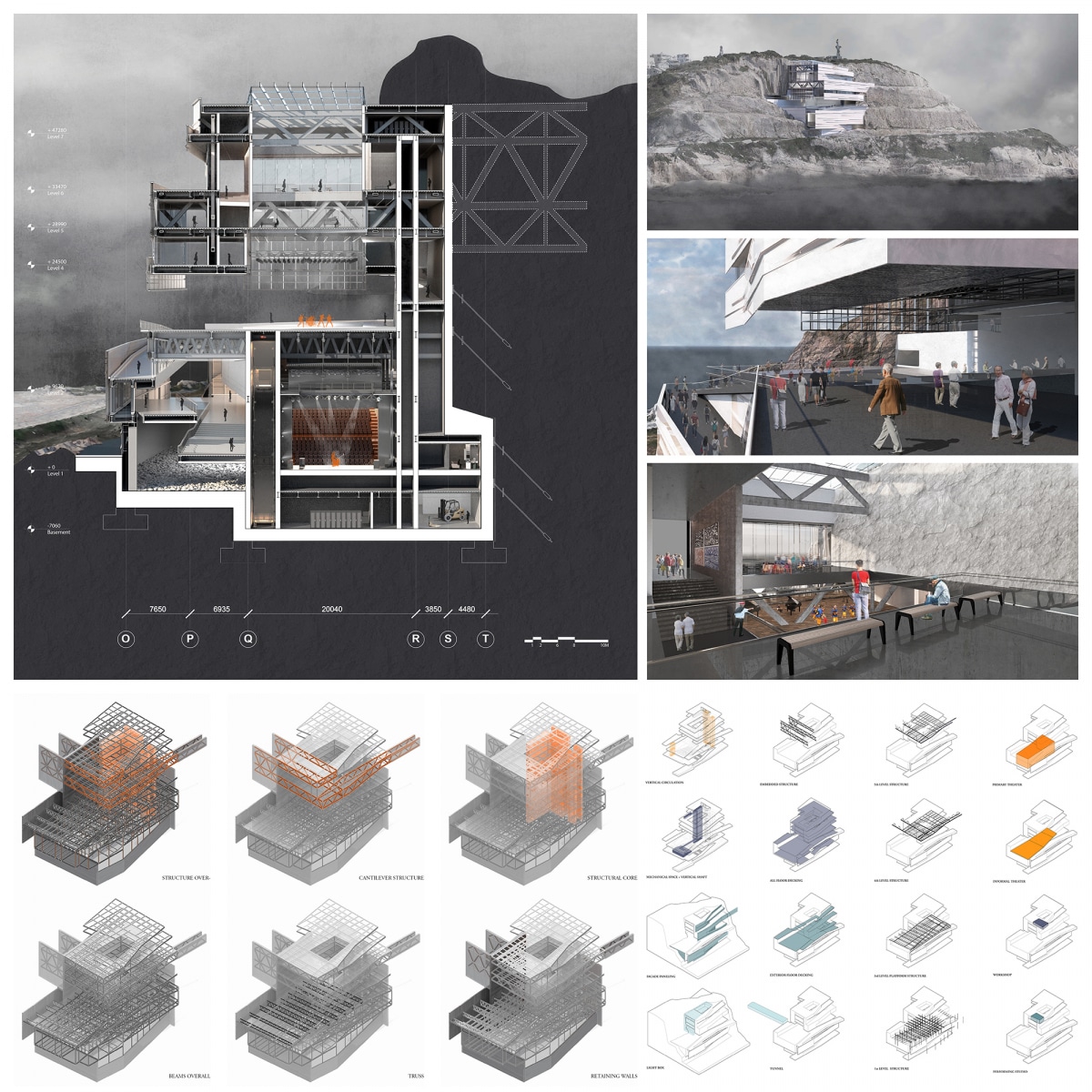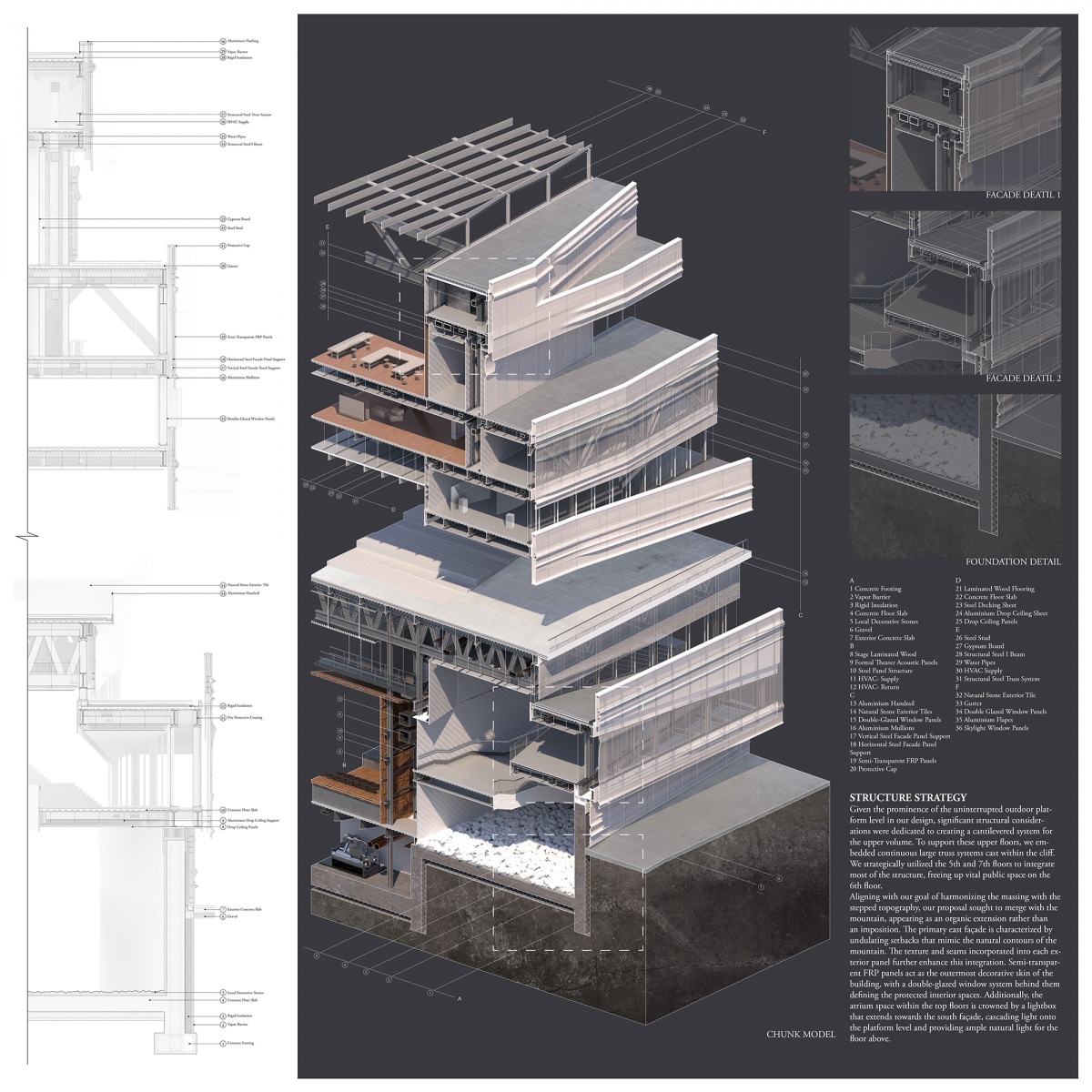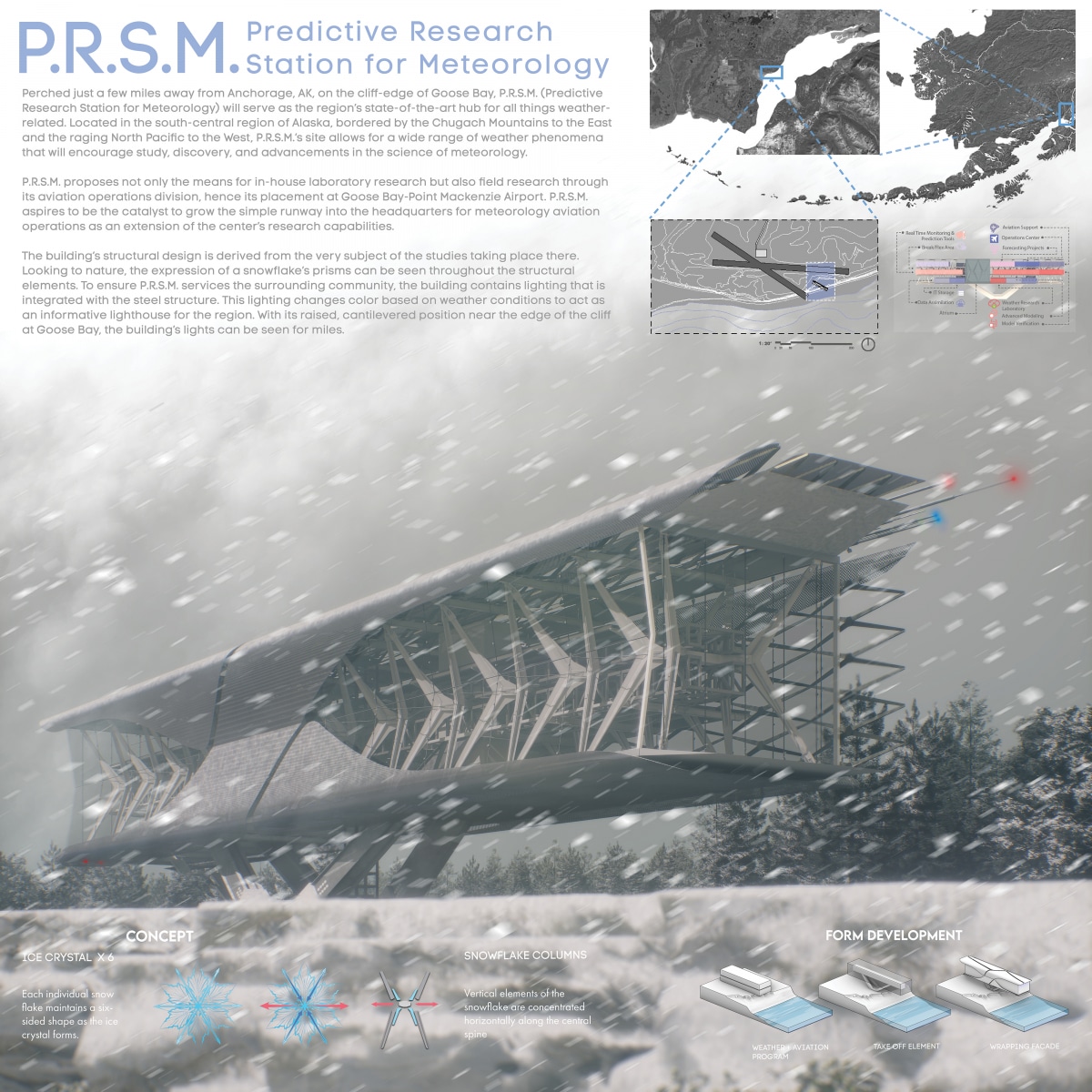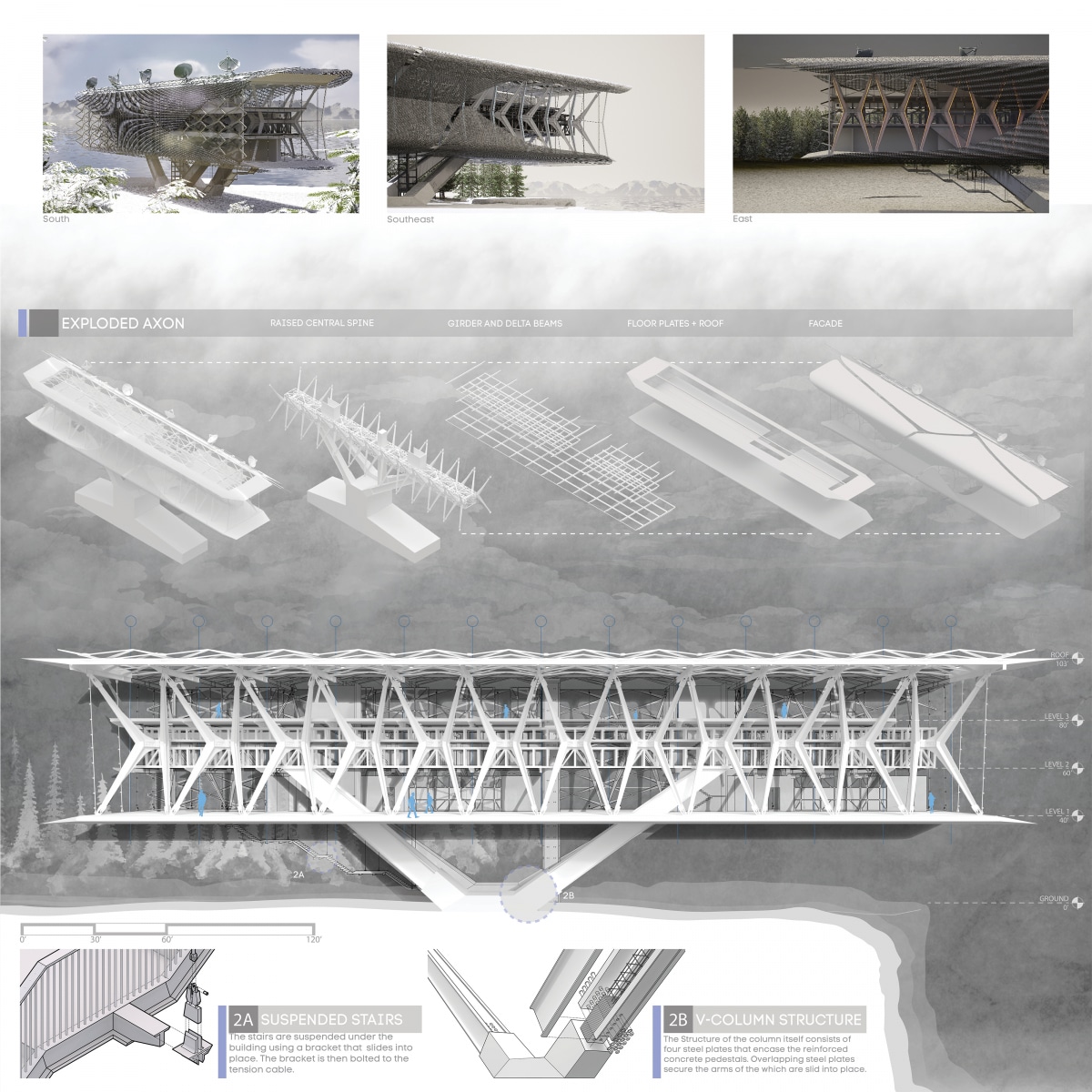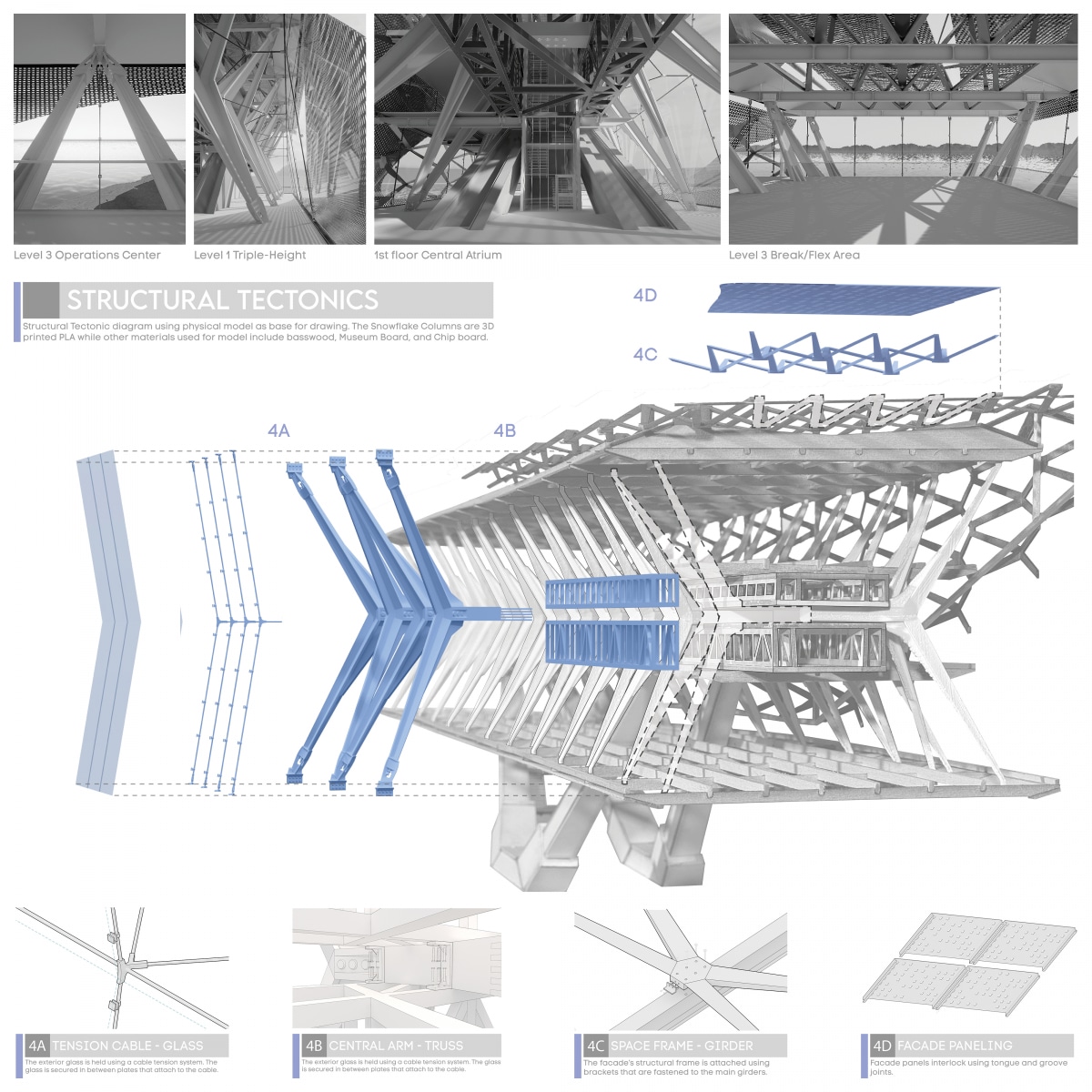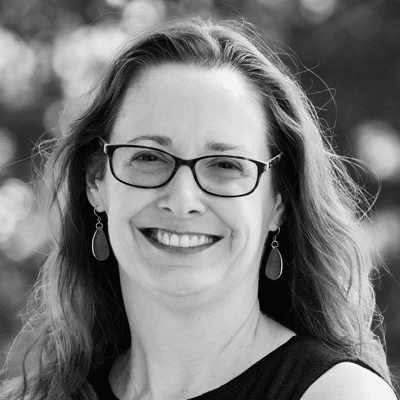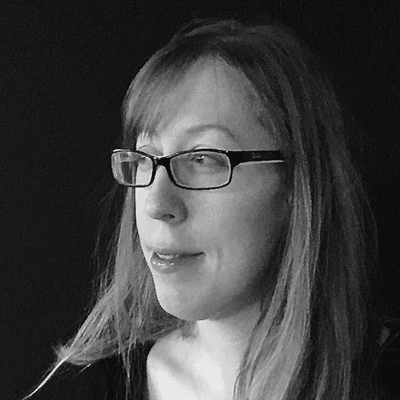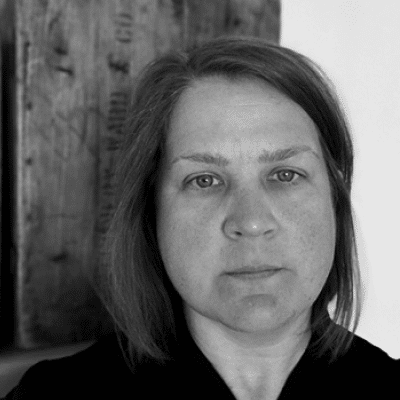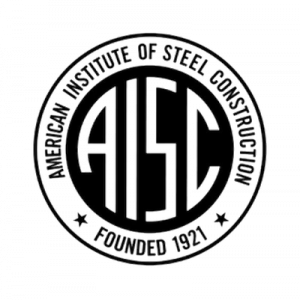WINNERS OF THE 2024 STEEL COMPETITION
The American Institute of Steel Construction (AISC) and the Association of Collegiate Schools of Architecture (ACSA) are pleased to announce the recipients of the 2024 Steel Design Student Competition. The competition recognizes eleven exceptional projects, in two categories, that explore a variety of issues related to the use of steel in design and construction.
CATEGORY I: STEEL INNOVATION CENTER
This category asks students to design a Steel Innovation Construction Center in downtown St. Louis, MO. The site is part of the Construction Innovation District & Master Development just south of the Gateway Arch. Program spaces include areas for exhibition, fabrication, training, and community outreach. Steel is the primary material.
CATEGORY II: OPEN
Offers architecture students the opportunity to select a site and building program using steel as the primary material. This competition category permits the greatest amount of flexibility for any building type.
1st Place

The Exploration of Expression
Students: Russell Tong & Porter Watson
Faculty Sponsor: Carlo Sturken
Institution: Woodbury University
Juror Comments: The Exploration of Expression provides a clear and concise program with great detailing in the sophisticated graphics. A playful design using the structure as part of the architecture in a poetic way. The extension of the existing Mural Mile wall is inventive and playful.
Project Description
The Exploration of Expression Steel Center is an extension and continuation of the city’s Mural Mile Wall, a section of the Mississippi River flood wall adjacent to the site. This wall is part of the annual event held by the city that brings people together as a community where they paint, tag, and decorate a portion of the flood wall. This steel center alludes to the practices of street art that are used on the Mural Mile Wall, then allowing itself to act as a literal and metaphorical extension of the existing wall.
1st Place

O.P.C.S. T-157 [Garbage Monster]
Students: Logan Jacobs, Jude Bell & Christian Salazar
Faculty Sponsors: Pasquale De Paola & Kevin Singh
Institution: Louisiana Tech University
Juror Comments: O.P.C.S. T-157 [Garbage Monster] is a provocative well-executed design of infrastructure as architecture. The students created ocean architecture that appears as a vessel for recycling plastics.
Project Description
Each year, rivers carry an estimated 1.15 to 2.41 million tons of plastic into the oceans, adding to the already significant accumulation. This plastic gathers in the ocean’s gyres, with the largest and densest collection being the Great Pacific Garbage Patch, which covers 618,000 square miles between Hawaii and California. An issue of these proportions requires a solution of equal magnitude.
We propose the T-157 “Garbage Monster,” a key component of the Ocean Plastic Collection System (O.P.C.S.). This vessel includes an on-board recycling center, a tower of pods for worker accommodations, and a fleet of aerial and nautical drones. The aerial drones identify “hotspots” of garbage, while the nautical drones work in pairs to collect the plastic using a dragnet system. After gathering sufficient plastic, the drones return to the main vessel to deposit their collections. The crew then cleans, sorts, bales, and stores the plastic on-board until exportation back to land.
2nd Place
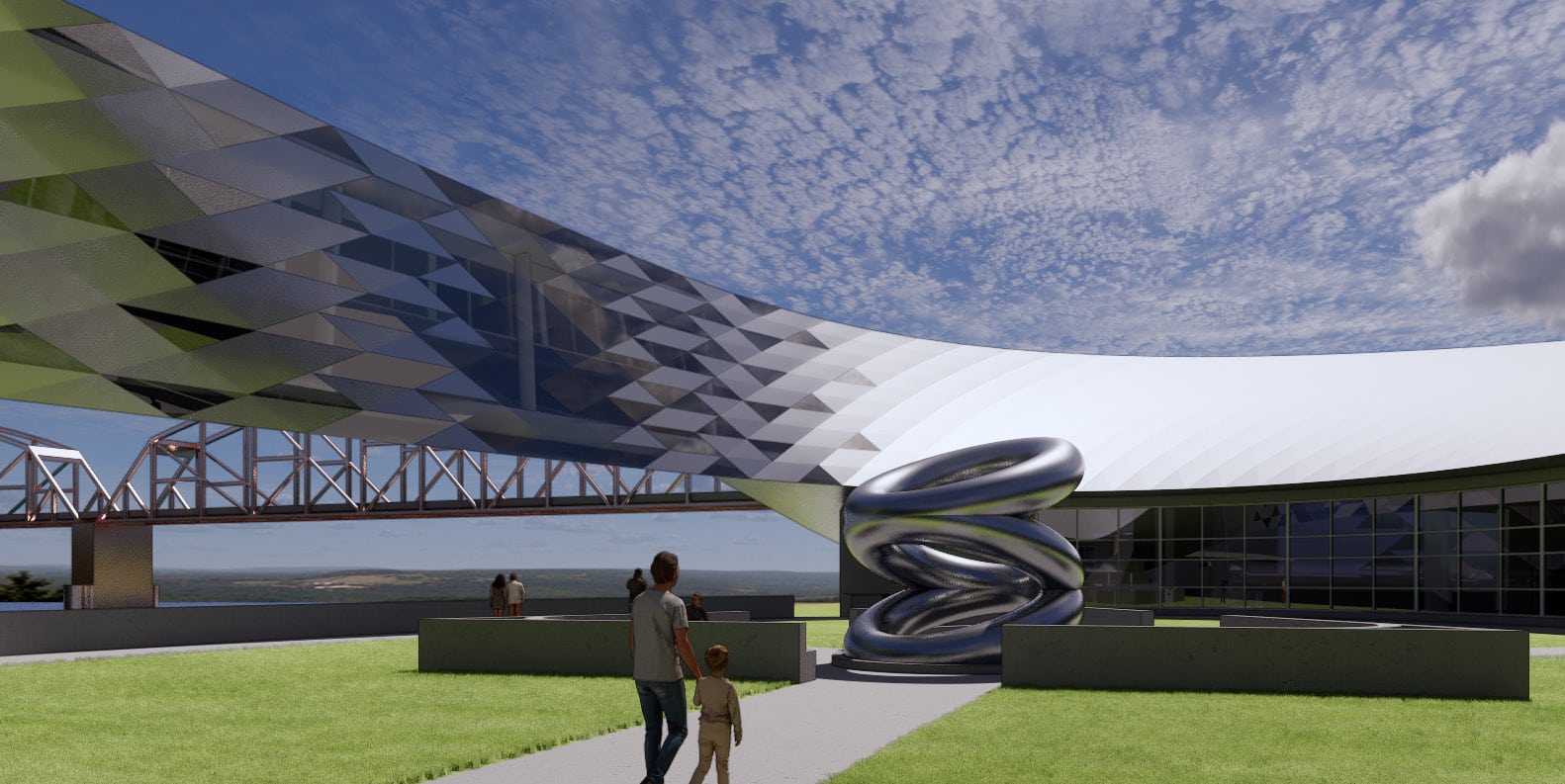
Infinite Innovation
Student: Eric Duenser
Faculty Sponsor: Randall Deutsch
Institution: University of Illinois, Urbana-Champaign
Juror Comments: Infinite Innovation designs a creative round-space steel frame that provides efficiency in the structure. The building appears to levitate over the river wall is a novel way to engage the site.
Project Description
Drawing inspiration from the extruded triangular form of the Gateway Arch, this project aims to create a new, unique geometrical form for the Mississippi riverside. Its toroidal, twisting shape is reminiscent of a three sided Möbius strip, nesting a center courtyard that looks over the site’s levee wall and out over the river. Its unique shape means that it only has one side since the walls rotate with the twist and subsequently continue to form the roof and floor. The seamless steel and glass panels account for the twist, fading in and out with the angled walls to effectively use daylighting. The glass paneling also reveals the unique structural supports required to hold up the long span cantilever while still retaining the building’s sculptural form. The over 100,000 square feet of program primarily focuses on the development of new steel and structural technologies. The structure, being a marvel of steel innovation on its own, seeks to inspire its researchers in their efforts towards said innovations.
2nd Place
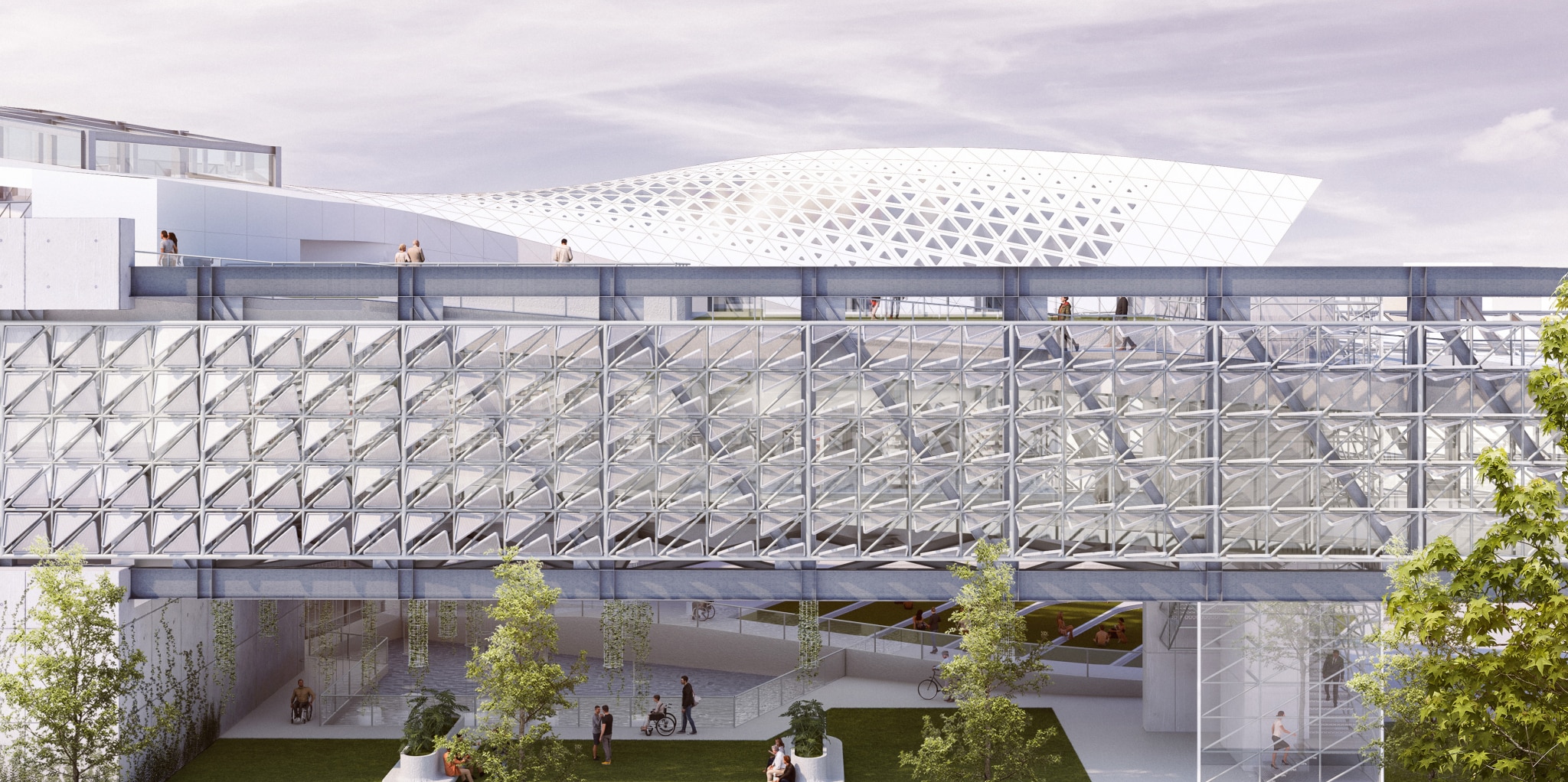
Liminal Library
Student: Collin Rohr
Faculty Sponsors: Lee Su Huang & Sarah Gamble
Institution: University of Florida
Juror Comments: Liminal Library uses a variety of structural systems that feels innovative and beautifully detailed. There is a marriage between the building and the steel forms that addresses sustainability in an effective way.
Project Description
Liminal Library challenges traditional concepts of accessibility, conceptualizing a library and enabling center with the idea of creating a unified experience, regardless of one’s capabilities. Situated in a flood zone, the site has a base flood elevation set at nine feet to prevent flooding during frequent hurricanes and intense storms.
To resolve these challenges, the site was organized around an ADA-compliant ramp that progressively moves people from the entrance of the site to a rooftop green space that overlooks the harbor. The vertical rise generated by the ramp not only addresses the flooding issues but also reclaims the ground and rooftop space of the site, giving it back to the community of St. Petersburg.
Structurally, steel was the only resolution to this concept, expressing the vast capabilities steel has in a beautiful dichotomy of tectonic and stereotomic systems that align programmatically.
The expressed tectonic system, composed of a large steel truss houses the library within its depth, holding nearly 30,000 volumes and reading/lounge space, spanning over the site and shading the space beneath.
The concealed stereotomic space truss bends and twists around the tectonic system, housing the larger, open spaces of the enabling center such as the community meeting space and main lobby, projecting north to open the building to optimal lighting.
To conceptually unify the dichotomy, positive and negative variants of a triangular panel system were applied to the tectonic and stereotomic systems. The positive system clads the tectonic library as a solar-responsive panel system. Made of perforated steel, the panels open and close to control the interior lighting and keep the building cool. The negative system subtracts triangular voids from the enabling center that work within the space truss, giving the illusion of a solid mass that has been carved away from.
3rd Place

Gateway South Innovation Center
Student: Sulaima Salim
Faculty Sponsor: Osman Attmann
Institution: University of Colorado Denver
Juror Comments: Gateway South Innovation Center is a design with a focus on adaptability (expansion and contraction based on innovation center needs), which is the key to this beautifully detailed building. The building has an industrial elegance with excellently rendered drawings, creative use of daylight, and clear steel structure.
Project Description
Transformative Architecture refers to the adaptability of buildings over time and how these buildings function from Past to Future. It involves making changes & Improvements to the context, which could be through materials, a sustainable structure, and an adaptable program. Transformation of buildings happens in response to varying conditions, such as promoting well-being, contributing positively to the environment and context as it evolves, and transforming to sustain elements that consider the longevity of the building and structure.
My design philosophy embodies this transformative approach through a focus on disassembly. The building functions as a prefabricated unit that arrives at the site with instructions and can be disassembled when the grid changes, additions, and subtractions are required. Featuring a pier foundation system for stability in a flood zone and a temporary over-grade grid system for flexibility, the design offers adaptability to meet the evolving needs of the researchers, trainees, students, and clients. This grid pier system will provide a dynamic solution, capable of growing quickly alongside St. Louis development to contribute to the Gateway South project that will become a central component of the “Construction Hub”.
Exposed Steel & structure run throughout the building design, creating a visually engaging experience as you move through its spaces. The interior program functions as a building machine that features varying levels connected by ramps, while a prominent skylight runs along the building’s major datum that also acts as a buffer zone (through a green biophilic wall). The datum became the exhibit, engaging the public in showcasing steel production and new technologies. The St. Louis Gateway South Innovation Center aims to position itself as a leader in these fields, drawing inspiration from the site fabric and its vision for the future.
3rd Place

Almaraz Cross-Creation Hub
Student: Benjamin Shapiro
Faculty Sponsor: Inés Martín-Robles
Institution: University of Virginia
Juror Comments: Almaraz Cross-Creation Hub is a provocative design with convincing diagrams and a thorough steel plan. The porous diagrid structure works within the neighborhood allowing for art creation and gathering spaces at many scales.
Project Description
The Cross-Creation Arts Center is primarily a meeting place for the Chicano community, where art practices and groups that have been forced to secondary and temporary spaces are given a permanent home. The arts center exists at a primary location for gathering at many scales – at a metro transit line so latino/chicano community members from around LA can easily access it, between two key commercial corridors in the Boyle Heights neighborhood and bridging two areas with prominent existing public art.
The porous diagrid structure contains a series of workshops and display spaces levitating within it and supports art creation and gathering at many scales. The first floor of the structure is lifted above the ground so the public plaza extends into a covered space under the arts center creating a 24-hour accessible space always available to the public. A primary exhibition space moves beyond the confines of the frame and invites the community to interact with the art. As you move up the building, a variety of scales of workspaces sit in the frame and create a public commons between them for display, collaboration and cross-pollination of ideas. The structural stability of the diagrid allows the workshops and display spaces to function as adaptable shells which will continue to support the community as their needs develop over time. These shells can be quickly assembled or expanded along the grid with simple, cheap materials that supports the community driven capacity for self-determined use.
Honorable Mention
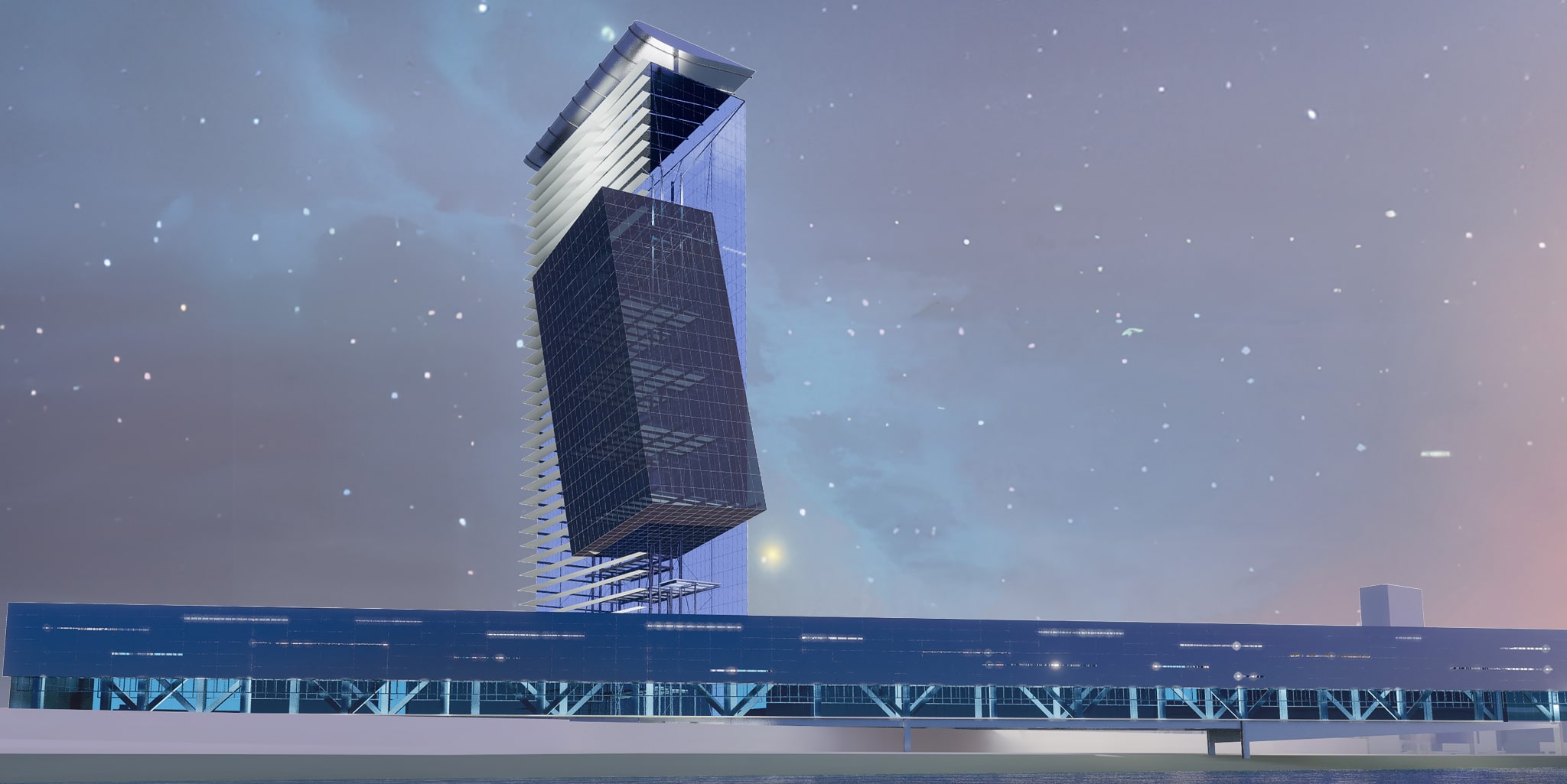
Skyforge/Steel Horizon
Students: Kevin Bui & Garrett Gudmundson
Faculty Sponsor: Gerard Smulevich
Institution: Woodbury University
Juror Comments: Skyforge/Steel Horizon is grounded in the St. Louis location connecting the site to the sky. The simple steel design used in the cantilever harkens back to the industrial surroundings.
Project Description
Situated in St. Louis along the Mississippi River, Skyforge/Steel Horizon is a steel innovation center dedicated to the design, education, and exploration of steel and its possibilities. The project delves into the intersection of the vertical sky and horizontal land, symbolizing the genesis and realization of ideas—where the sky signifies idea formation and the land embodies their implementation.
Skyforge/Steel Horizon seeks to push the boundaries of steel, exploring various aspects of design such as space, orientation, and climate control. These elements are central to the project’s design philosophy.
As the city becomes increasingly fragmented and isolated from its inhabitants, Skyforge/Steel Horizon aims to draw people in with its transparent design. The tower’s transparency and height spark interest and desire to visit from all around the city.
The design features three interconnected open bays that cantilever over the river’s flood wall. This configuration allows for efficient loading and unloading from the bay’s underside and over the river, facilitating access to river shipments. This streamlined approach optimizes material movement within the open bay.
Honorable Mention
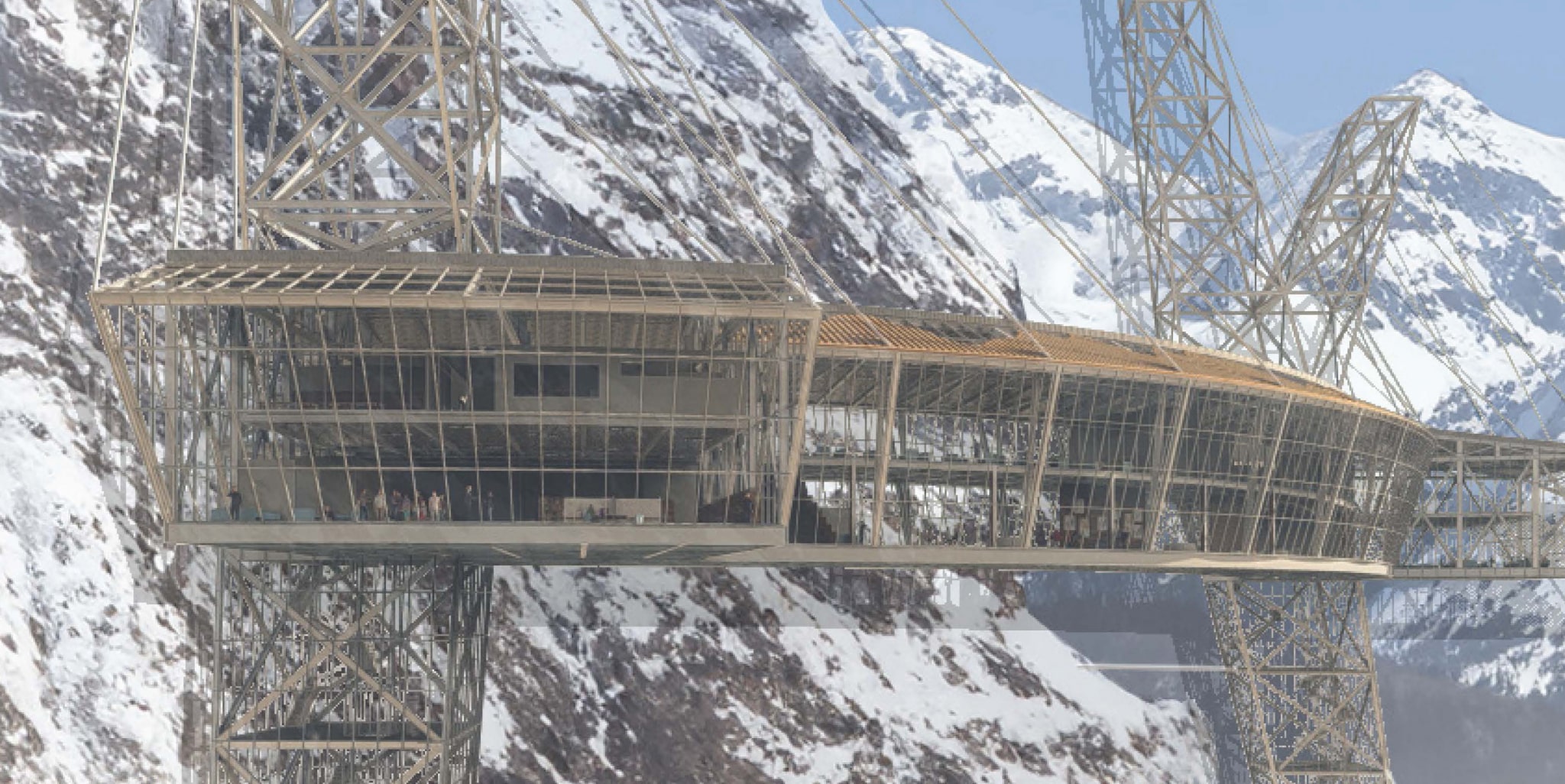
Spires Mendenhall Research Center
Students: Noah Berryhill & Alex Klocek
Faculty Sponsors: Pasquale De Paola & Kevin Singh
Institution: Louisiana Tech University
Juror Comments: Spires Mendenhall Research Center has captivating images and renderings that provoke the mind. The natural surroundings of the Alaskan frontier is an unexpected location for such a large steel structure.
Project Description
SPIRES
Mendenhall Research Center
Located in the southern Alaskan Panhandle, situated between the Gulf of Alaska to the west and British Columbia to the east, the 1,500 square mile Juneau Icefield has existed for over 3,000 years since the Little Ice Age. The Mendenhall Glacier extends from the Juneau Icefield approximately 13 miles south to where it exits the valley into Mendenhall Lake.
With its proximity to Juneau, Alaska, a popular tourist destination and port city for Alaskan cruise ships, drawing more than 1.15 million tourists annually, Mendenhall Glacier was deemed an ideal location for a research facility and observatory for the study of, and educational awareness about, glaciers. Due to a general warming trend in our climate and the rate of retreat of the world’s glaciers, it is imperative that resilient, sustainable steel structures, like SPIRES, be built to observe, research, and learn from what is currently taking place.
The two-level, curved, steel structure of the SPIRES Mendenhall Research Center mimics the topography of the steep eastern slope directly adjacent to and overlooking the Mendenhall Glacier. This was purposeful in the design, as a main factor was the minimization of the building’s contact with, and impact on, the surrounding environment; thereby, reducing the need for any major excavation of the mountainside or potential destruction of the glacier itself. Preservation and conservation were of utmost importance. A spire and gondola system incorporated into the building design was used to accomplish this, giving the sense that the building appears to “float” on top of the landscape. Additionally, to allow for maximum glacier-viewing vantage points for visitors, the entire outward-facing curved surface is steel-supported windows.
The SPIRES Mendenhall Research Center represents a union between steel and the natural surroundings of the rugged Alaskan frontier, highlighting the potential for innovation in design that can also support environmental conservation. An architecturally expressive design, SPIRES lends awe to an already awe-inspiring natural phenomenon that few people get to experience up close. The building’s engaging design elements provide an inspirational foundation for research and education for now and future generations.
Honorable Mention
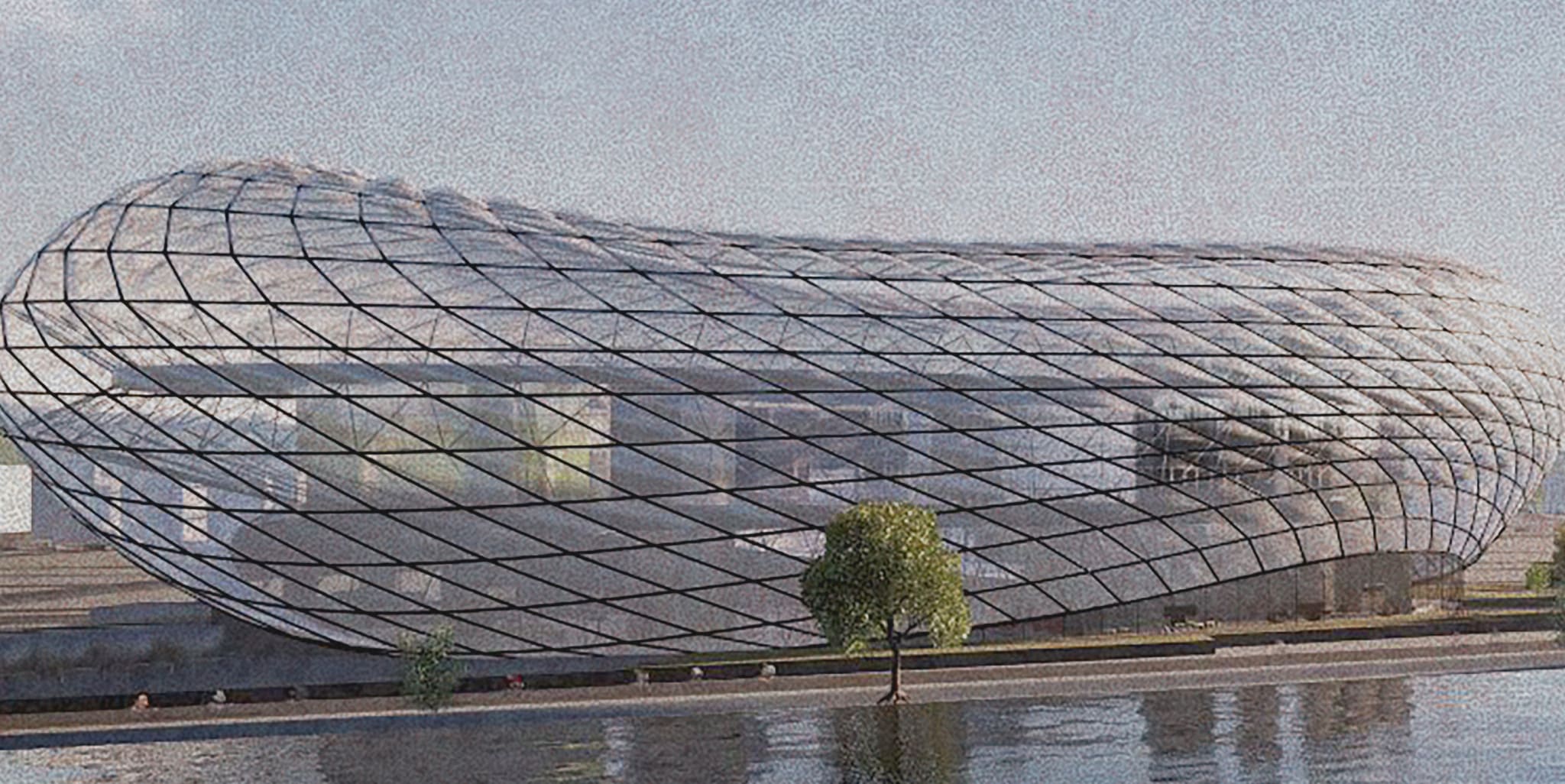
Overlapping Illumination
Students: Cristian Gomez & Mo Zaina
Faculty Sponsor: Osman Attmann
Institution: University of Colorado Denver
Juror Comments: Overlapping Illumination is a playful project with a strong well-developed building section. The round-diagrid steel design creates a beautiful building that appears as an object.
Project Description
In the pursuit of creating a Steel Innovative Center that seamlessly integrates concept and functionality, our design philosophy is programmatically driven by a commitment to illumination and overlap, and functionally driven through the method of the building as a machine. The overarching goal is to craft a space that serves its primary purpose as a hub for steel innovation and creates a safe space to care for and educate children while contributing to the visual and cultural landscape.
Overlapping Illumination epitomizes the fusion of form and function, embodying the essence of a living machine. Crafted with precision-cut nuts, bolts, and steel cables, every element showcases steel’s adaptability, speed, and resilience. Its expandable framework anticipates growth, while its transparent design fosters collaboration. Light dances through steel-framed windows, highlighting its industrial beauty. This building, temporary yet sustainable, heralds a new era of architectural ingenuity, showcasing steel’s limitless possibilities in every detail.
By embracing steel’s inherent properties, such as sustainability and efficiency, the project not only meets today’s needs but also anticipates tomorrow’s challenges. From the seamless integration of educational spaces to the incorporation of innovative design elements, every aspect of our Steel Innovative Center is meticulously crafted to showcase the potential of steel in a practical and inspiring way.
The heartbeat of our design philosophy is the pulsating overlap, where the clinks and clangs of steel creation resonate with the laughter of children. The childcare facility, infused with factory transparencies, becomes an interactive classroom, educating young minds in a way that mirrors the energy of the steel-making process. Simultaneously, adults find spaces tailored to their learning, fostering a community that embraces a culture of continuous education within the realm of steel innovation.
Illumination, as a guiding principle, goes beyond the literal sense of lighting up a space. It embodies the metaphorical light shed by knowledge and discovery. The Steel Innovative Center, conceived as a lantern, symbolizes the enlightenment that comes from understanding the intricacies of steel production. Positioned adjacent to the St. Louis Arch, this beacon of learning becomes a gateway to a world where steel innovation and education dance together in the limelight.
In conclusion, the forge of illumination design philosophy is an ode to the intricate dance of steel and education. It weaves a narrative where the brilliance of steel innovation illuminates the minds of both the young and old. The Steel Innovative Center becomes not just a factory facility but a symphony of enlightenment, where functionality, overlap, and operational efficiency create a space that not only stands as a beacon of progress but also nurtures the seeds of knowledge and curiosity.
Honorable Mention
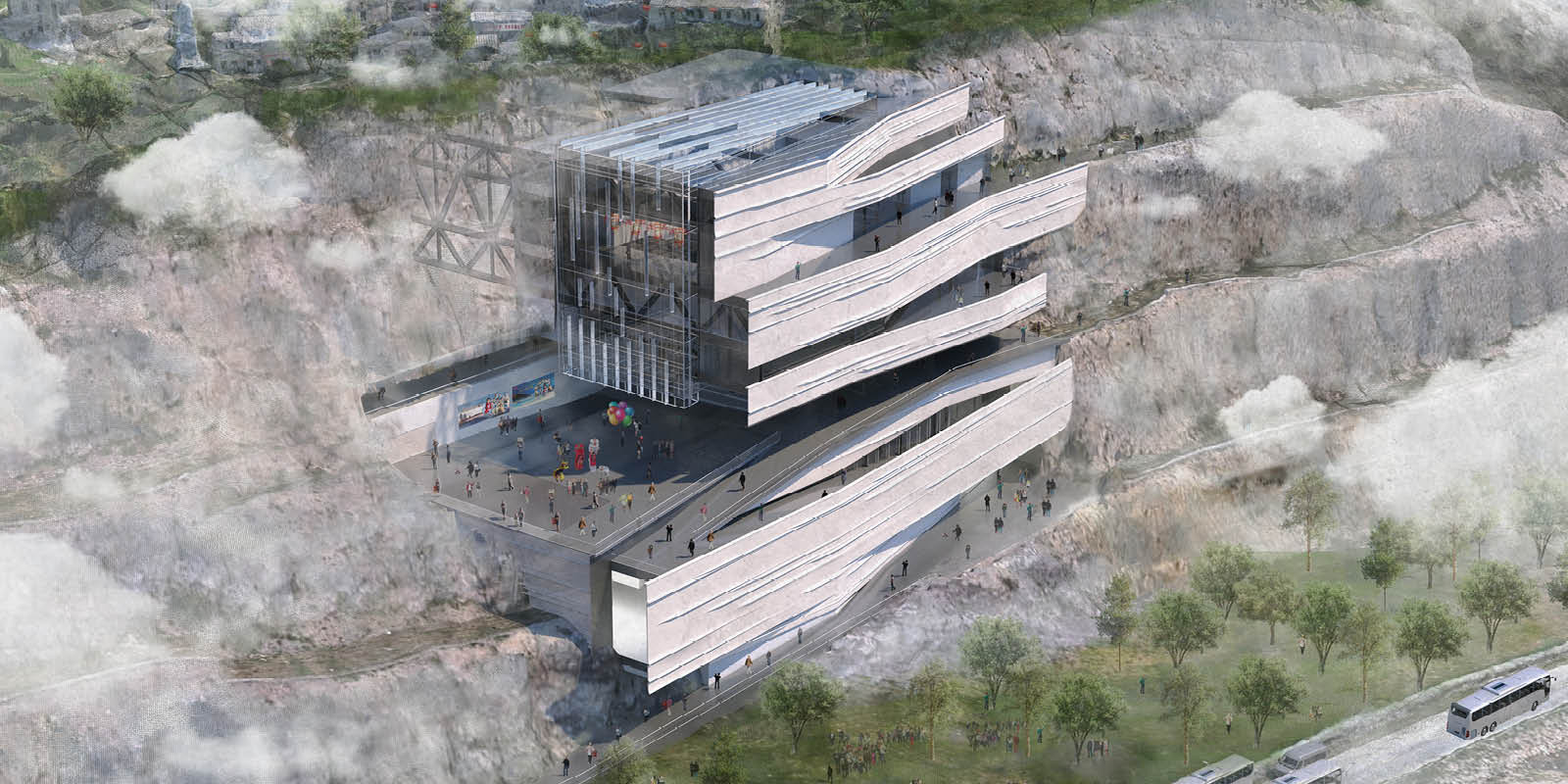
Performing On The Cliff
Students: Lucas Peiyu Luo & Adrian Suciu
Faculty Sponsor: Fei Wang
Institution: Syracuse University
Juror Comments: Performing On The Cliff is an incredibly thorough project with a complex program that celebrates steel. The project is a catalyst for cultural preservation and community revitalization.
Project Description
Embedded into a challenging cliffside overlooking the East China Sea, our proposal integrates immersive performance spaces within a larger cultural center for Wenling, China. The design draws inspiration from unique traditions and crafts found in this coastal region. Colorful crab shell paintings are just one of many art forms Wenling has become synonymous with, a reflection of the dominant fishing industry found here. Festive parades and musical performances are also common throughout the year. For generations, these events have celebrated local pride and strengthened this community.
More recently, with the younger population in China seeking opportunities in larger cities, smaller towns such as Wenling begin to fade. This project aims to create an institution that safeguards and preserves local culture while also offering outsiders the opportunity to engage with and familiarize themselves with traditions unique to Wenling.
The design prioritizes versatile performance spaces to accommodate a range of activities. A prominent open-air platform divides the building vertically into two sections. Acting as a main gathering point for both locals and visitors, the platform offers stunning ocean views and a flexible outdoor performance space. Users are then able to choose between a more traditional enclosed theater space below or a range of interactive spaces above. The upper half of the proposal holds several galleries, workshops, and studios. A strong gestural atrium cuts through this upper section right down to the platform level, enhancing visibility and engagement vertically. In response to the challenging site, the project’s meticulous treatment of vertical spaces ensures accessibility without compromising a profound experiential procession up the building.
Maintaining an uninterrupted outdoor platform level was essential for our scheme. Significant structural considerations were given to the upper volume, which becomes a large partial cantilever above. A continuous ring of trusses wraps around the fifth and seventh floors, extending to ultimately embed themselves into the cliff rock. These floors were strategically chosen to house most of the structure in order to free up vital public space on the sixth floor.
From afar, the terraced site topography intentionally aligns with the building’s massing. It was very important for the proposal to harmonize with the mountain, acting as a natural extension of the landscape rather than a separate imposing object. At a smaller scale, the primary facade is characterized by undulating contextual setbacks. Semi-transparent FRP panels create a decorative textured skin for the building, protecting interior space while still allowing some natural light inside. Lastly, a lightbox crowns the upper atrium space, allowing for the natural beauty of the site to spill inside once more.
In conclusion, this performing arts center and cultural institution asserts itself as an anchor for Wenling. The project not only addresses significant challenges posed by its unique location but also serves as a catalyst for cultural preservation and community revitalization, seamlessly blending tradition with innovation in both design and function.
Honorable Mention
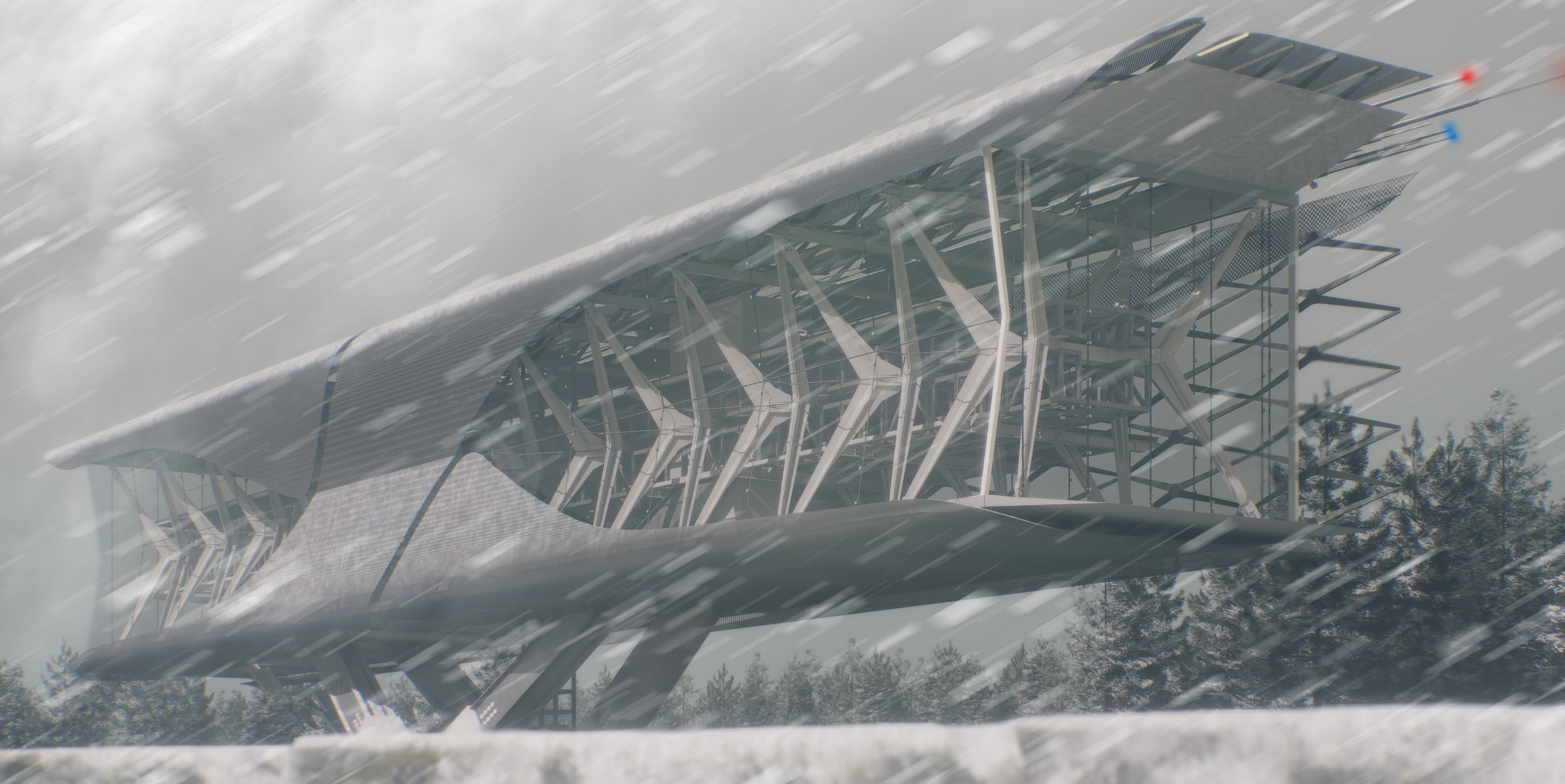
P.R.S.M
Students: Nathan Bucy & Alfredo Avendano Salcedo
Faculty Sponsors: Pasquale De Paola & Kevin Singh
Institution: Louisiana Tech University
Juror Comments: P.R.S.M is an exuberance of the steel structure that is both innovative and impactful. The building appears to have a light tough on the site as seen in the beautiful renderings and drawings.
Project Description
Perched just a few miles away from Anchorage, AK, on the cliff-edge of Goose Bay, P.R.S.M. (Predictive Research Station for Meteorology) will serve as the region’s state-of-the-art hub for all things weather-related. Located in the south-central region of Alaska, bordered by the Chugach Mountains to the East and the raging North Pacific to the West, P.R.S.M.’s site allows for a wide range of weather phenomena that will encourage study, discovery, and advancements in the science of meteorology.
P.R.S.M. proposes not only the means for in-house laboratory research but also field research through its aviation operations division, hence its placement at Goose Bay-Point Mackenzie Airport. P.R.S.M. aspires to be the catalyst to grow the simple runway into the headquarters for meteorology aviation operations as an extension of the center’s research capabilities.
The building’s structural design is derived from the very subject of the studies taking place there. Looking to nature, the expression of a snowflake’s prisms can be seen throughout the structural elements. To ensure P.R.S.M. services the surrounding community, the building contains lighting that is integrated with the steel structure. This lighting changes color based on weather conditions to act as an informative lighthouse for the region. With its raised, cantilevered position near the edge of the cliff at Goose Bay, the building’s lights can be seen for miles.
Participating Schools
The competition had over 900 participants from the following schools:
Academy of Art University, Auburn University, Ball State University, Belmont University, Boston Architectural College, California Polytechnic State University, California State Polytechnic University, Pomona, Carleton University, Carnegie Mellon University, Cuesta College, Florida Agricultural and Mechanical University, Glendale Community College, Harvard University, Kean University, Kennesaw State University, Louisiana Tech University, Madison College, Mississippi State University, Morgan State University, New Jersey Institute of Technology, Oklahoma State University, Prairie View A&M University, Rochester Institute of Technology, Savannah College of Art and Design, Southern Illinois University, Syracuse University, Texas A&M University, Texas Tech University, Toronto Metropolitan University, Universidad Anáhuac, University of Colorado Denver, University of Florida, University of Houston, University of Illinois, Urbana-Champaign, University of Kentucky, University of Maine at Augusta, University of Maryland, University of Missouri – Columbia, University of Nebraska-Lincoln, University of Oklahoma, University of Oregon, University of Southern California, University of Texas at Arlington, University of Texas at Austin, University of Toronto, University of Utah, University of Virginia, Virginia Tech, Washington University in St. Louis, Woodbury University
Competition Partners
Edwin Hernández-Ventura
Programs Coordinator
ehernandez@acsa-arch.org
202.785.2324
Eric Wayne Ellis
Senior Director of Operations and Programs
eellis@acsa-arch.org
202.785.2324

 Study Architecture
Study Architecture  ProPEL
ProPEL 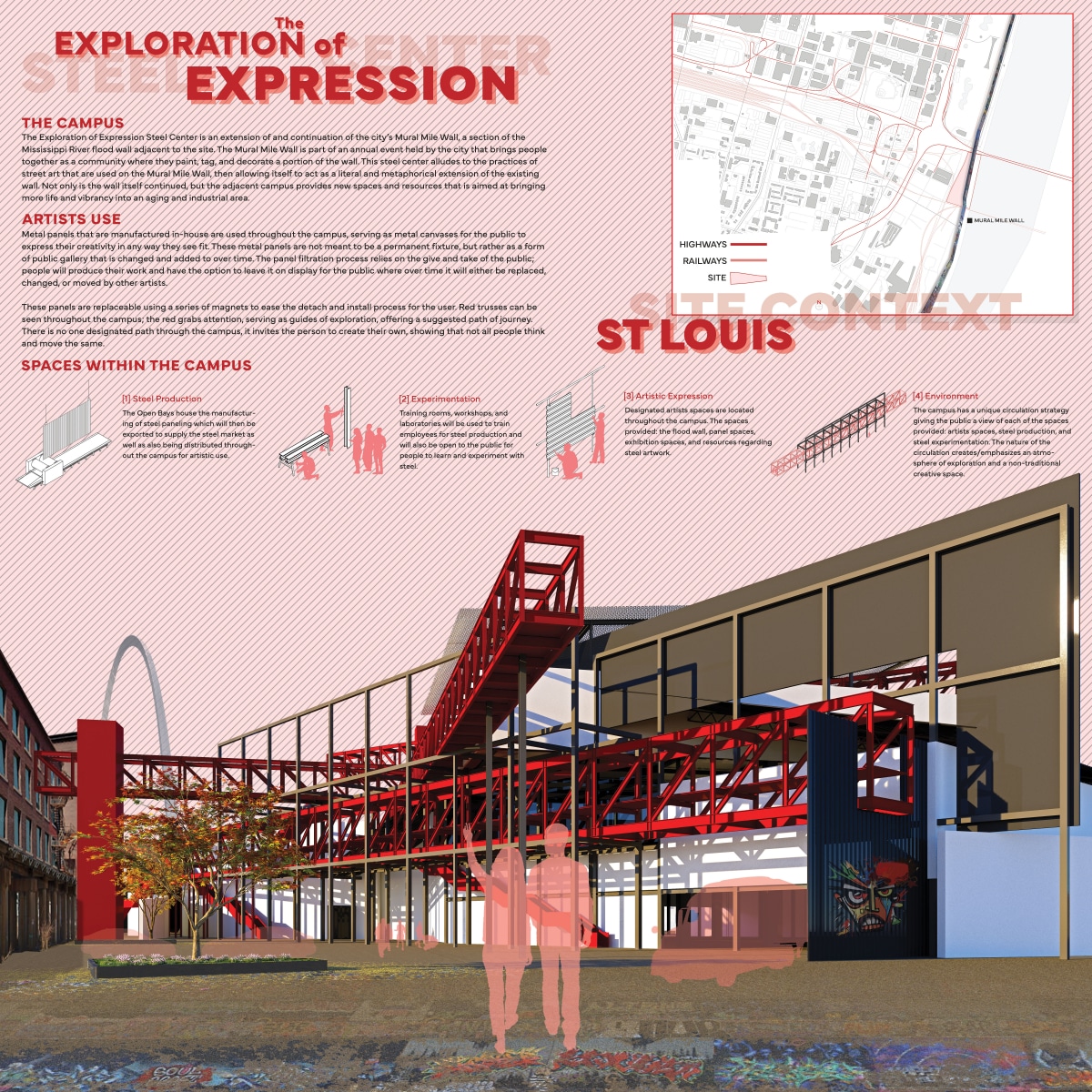
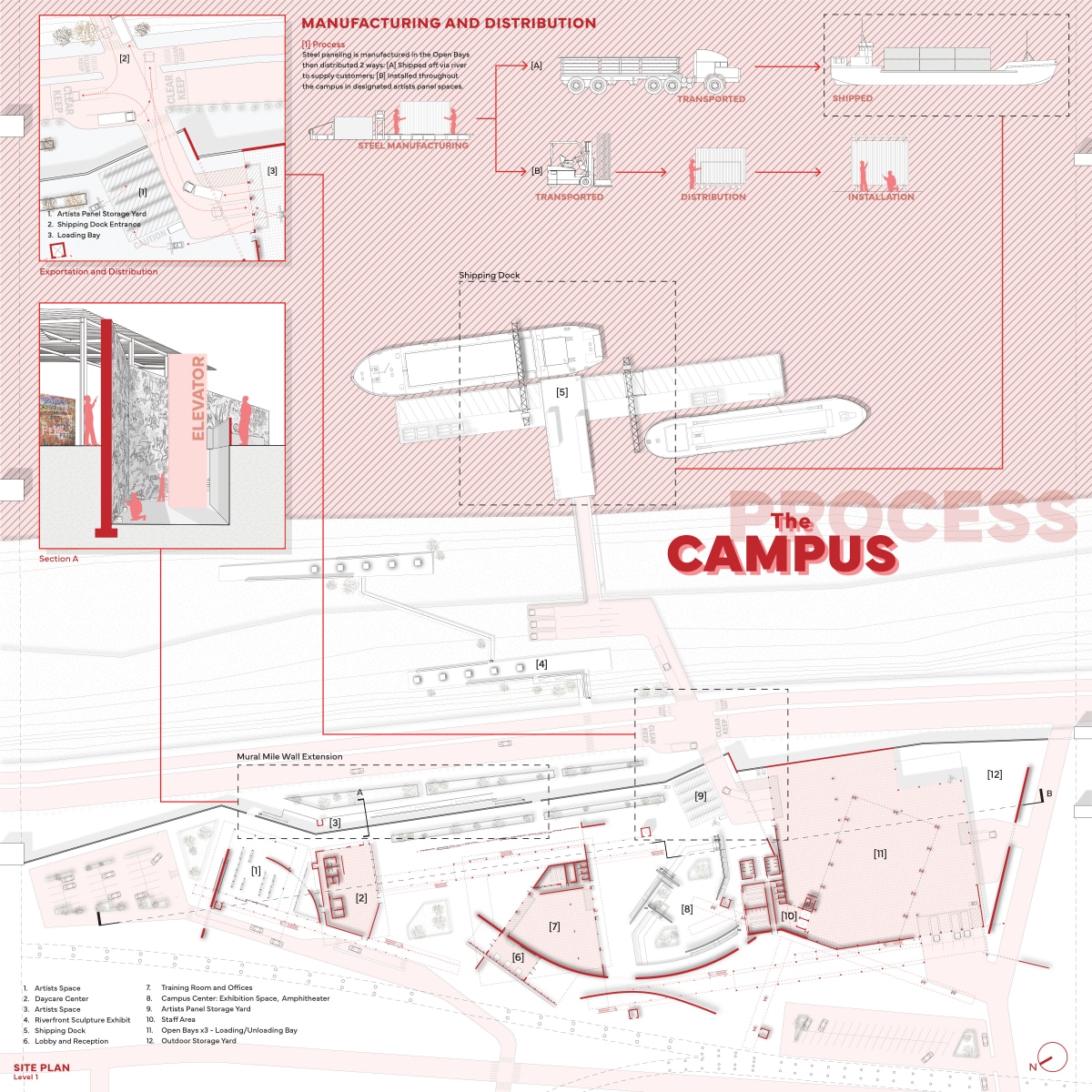
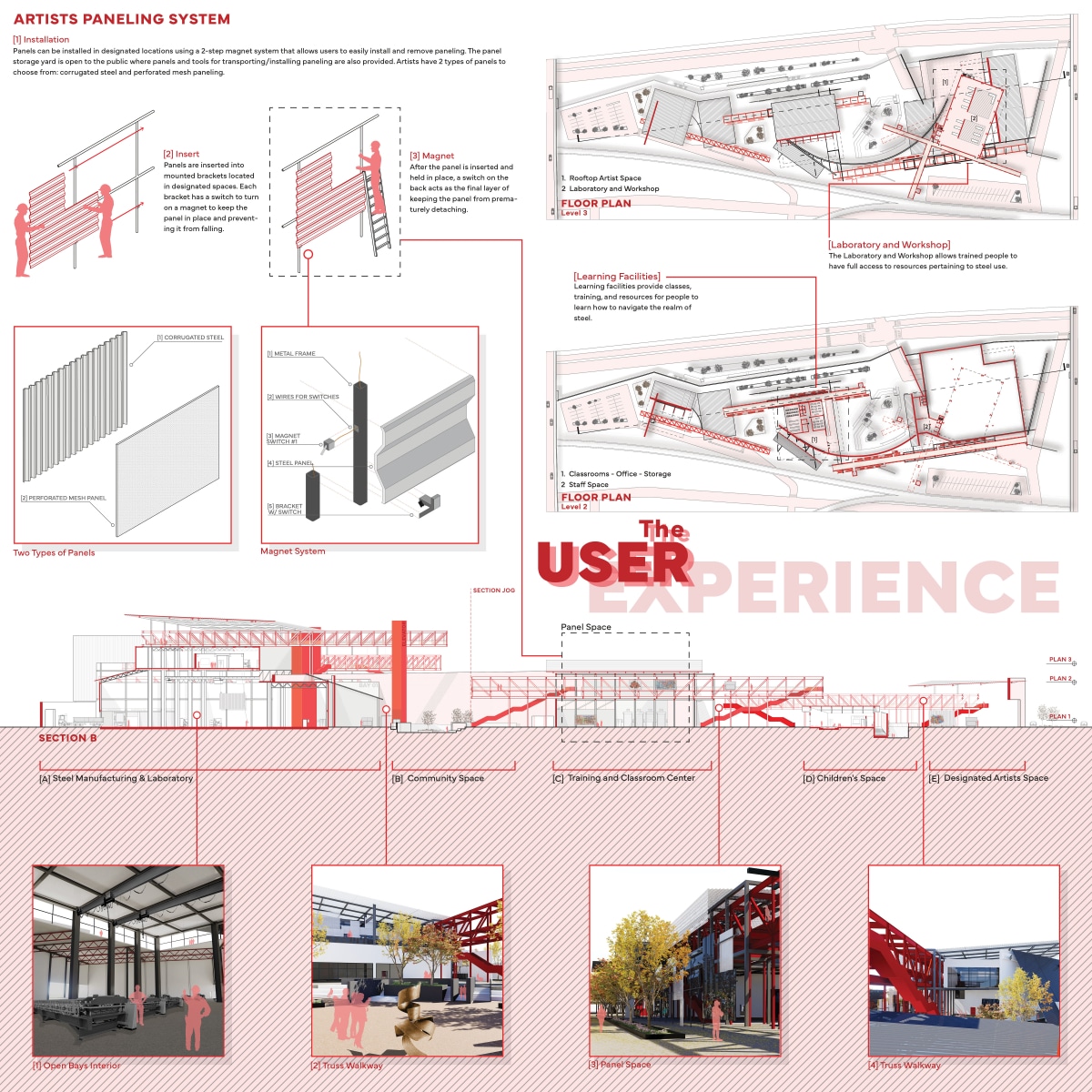

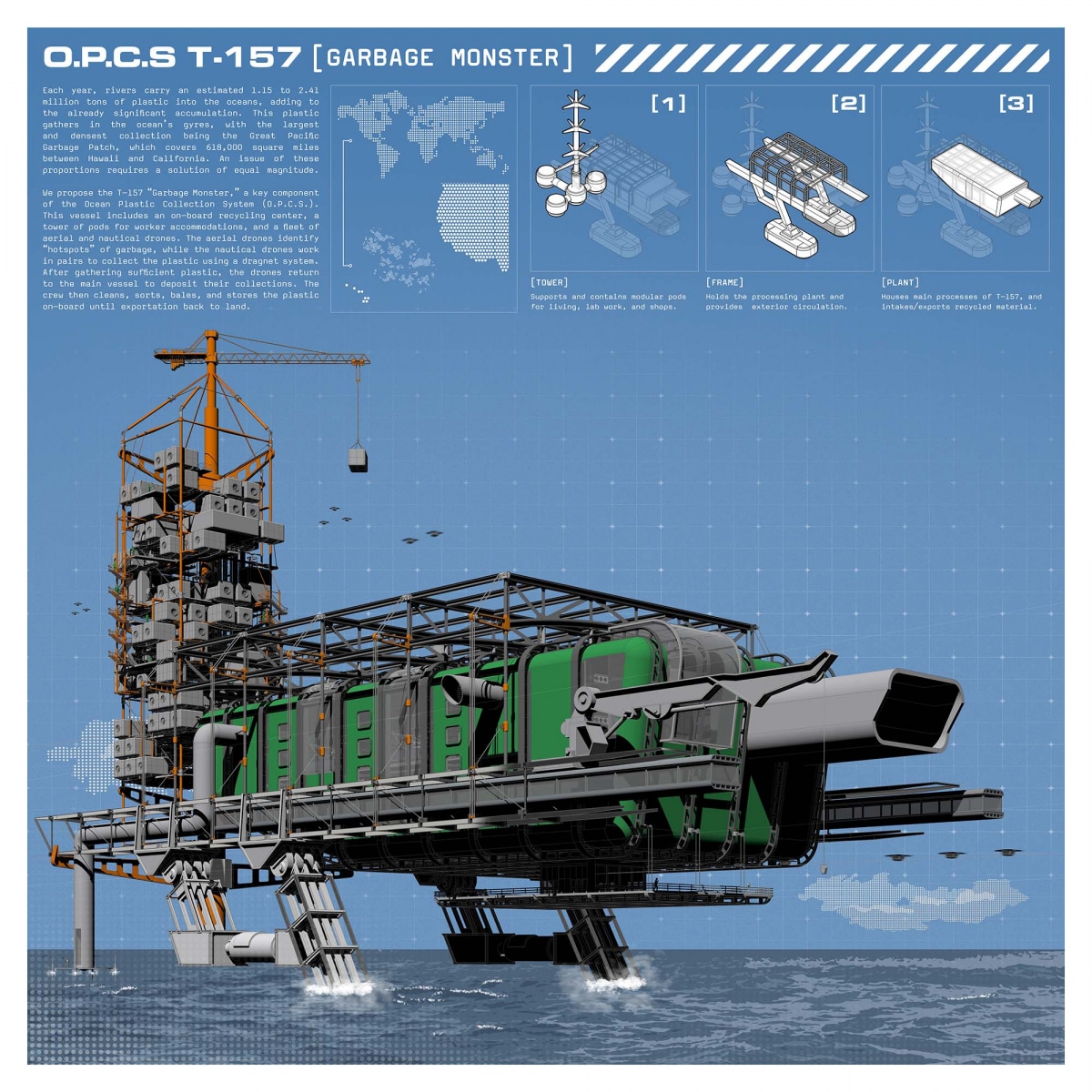
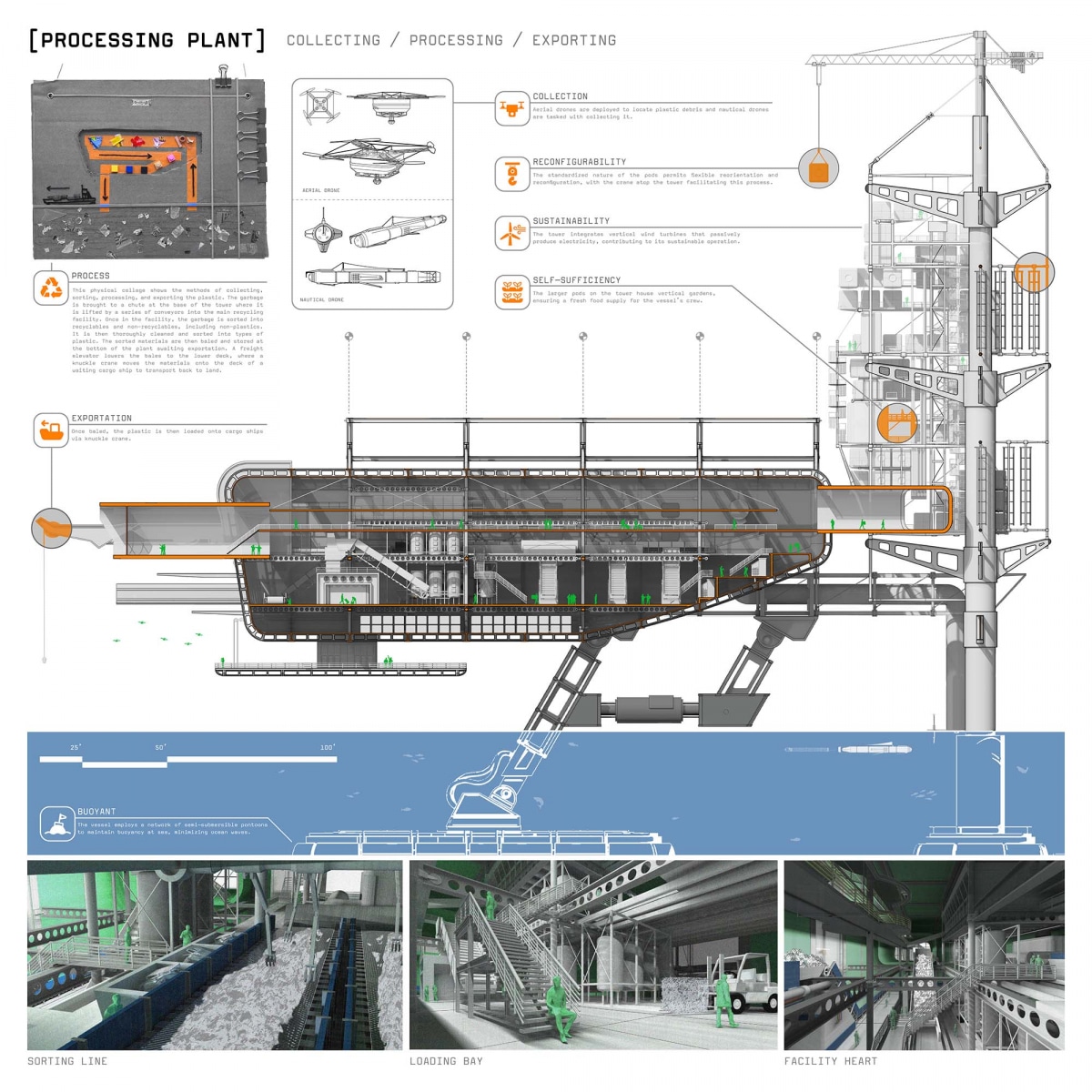
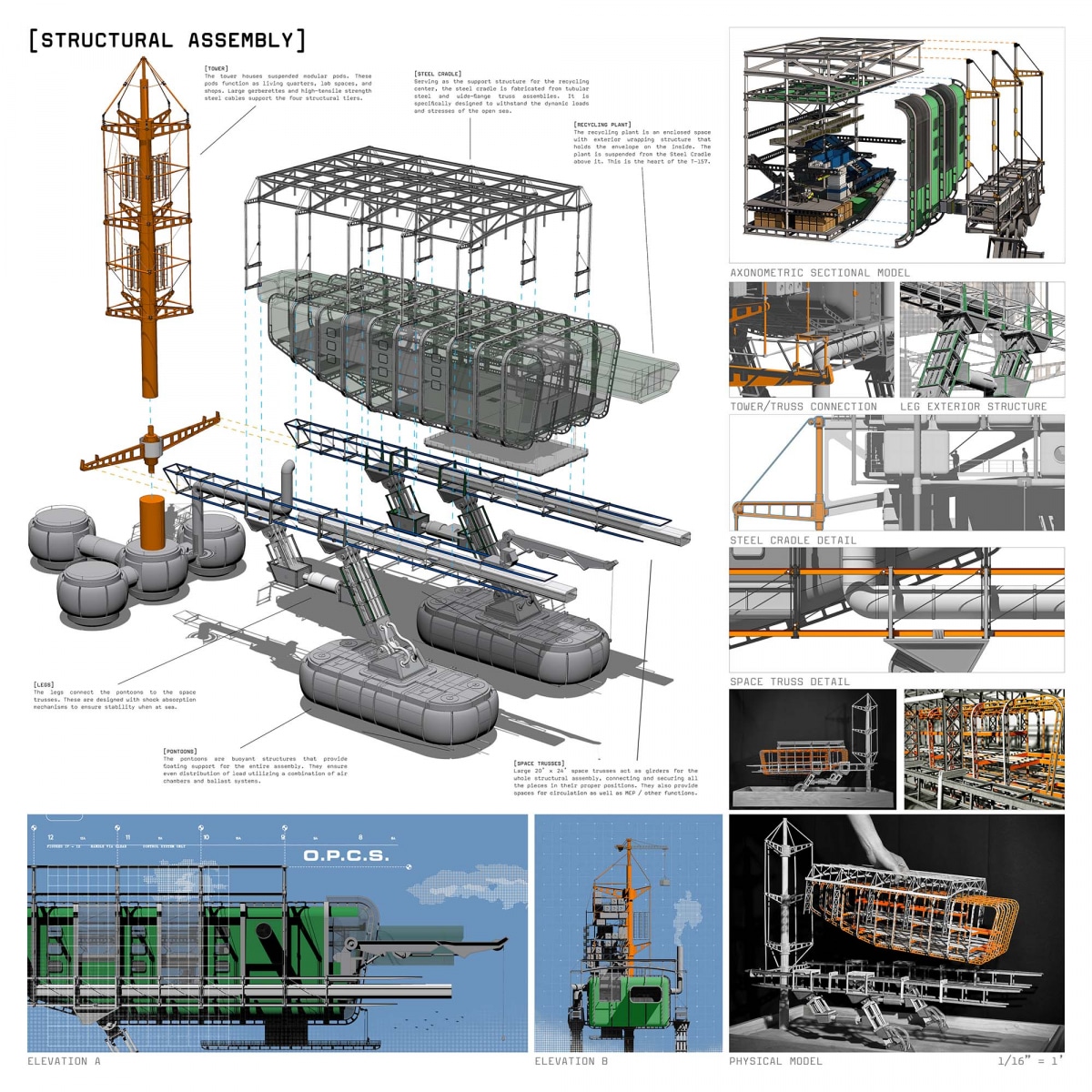
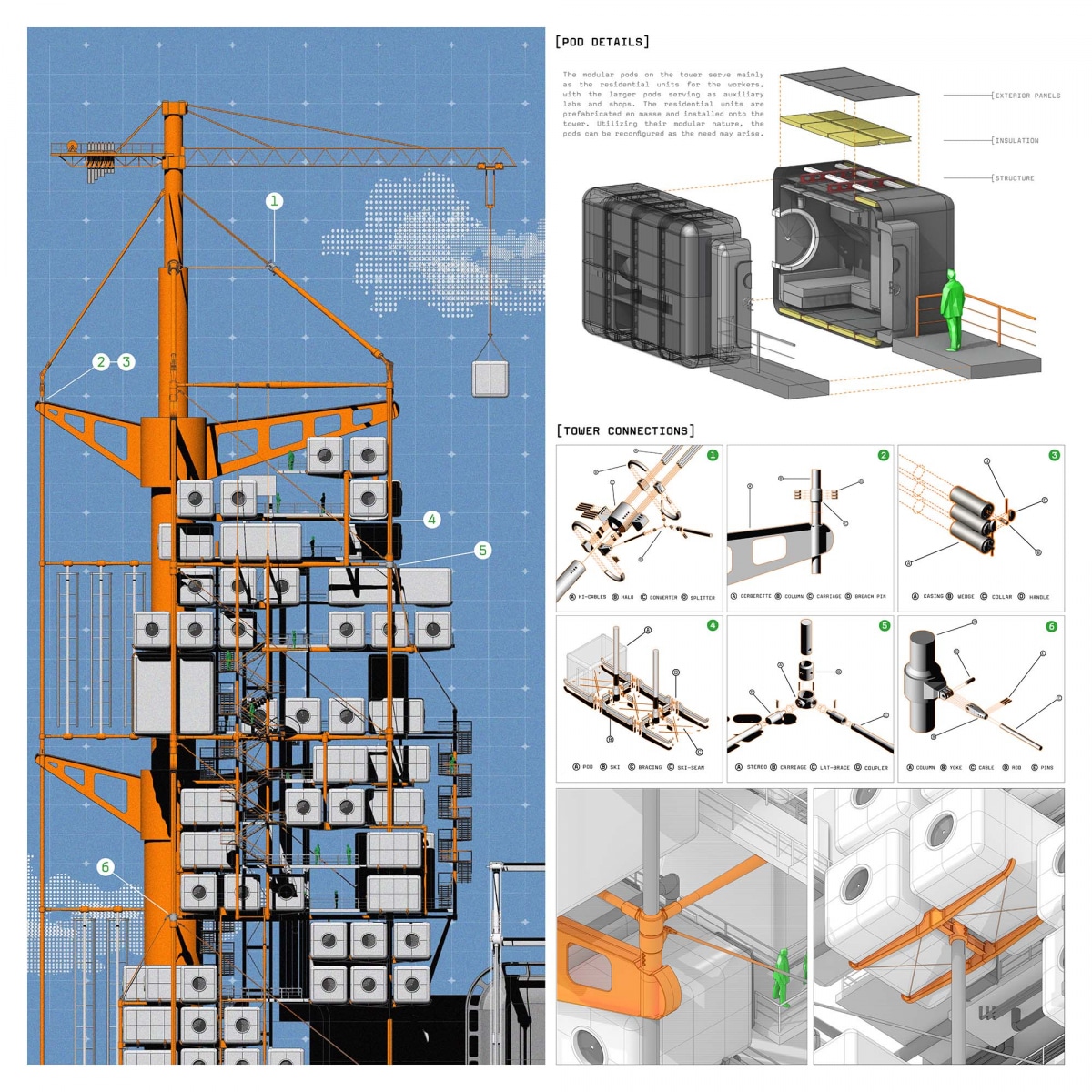

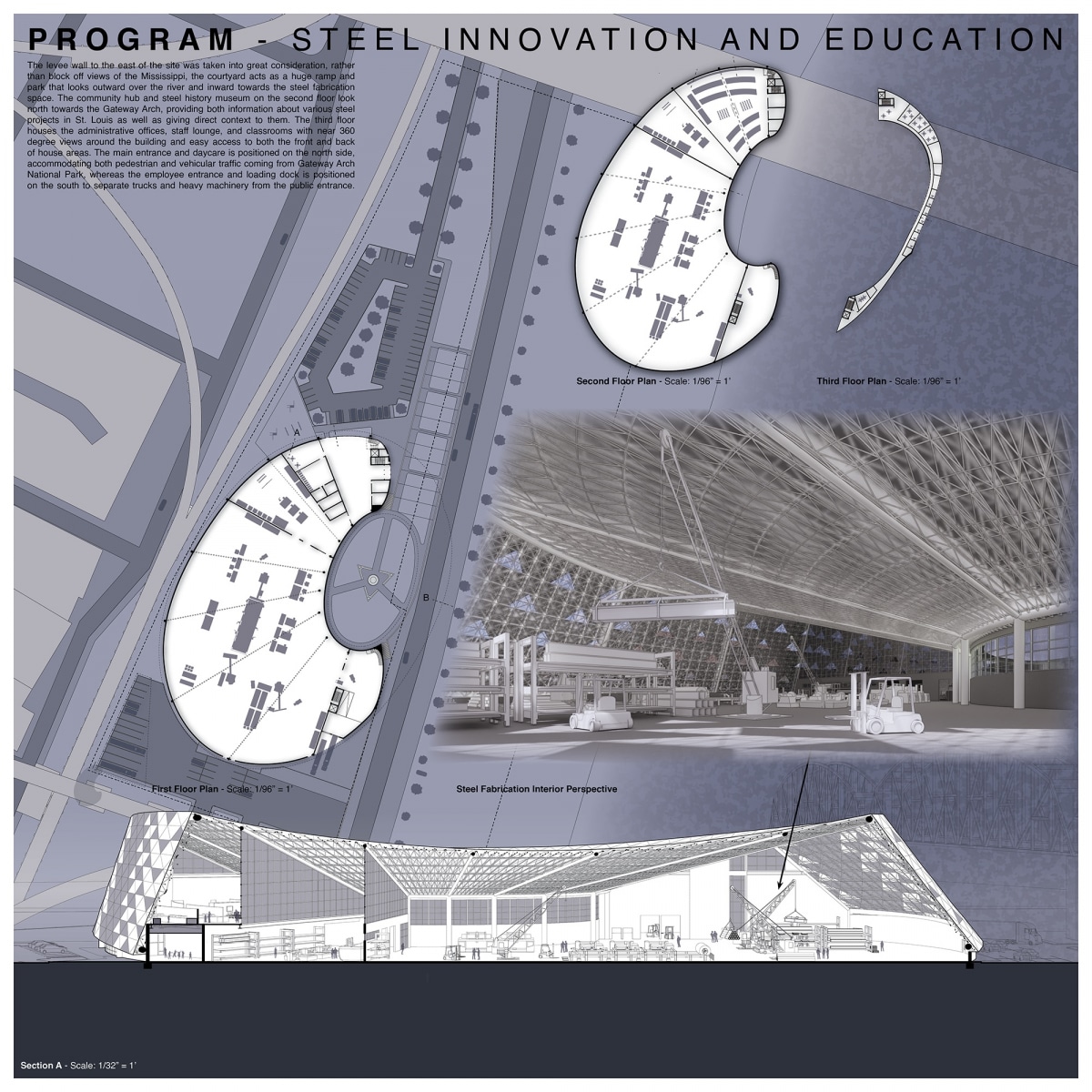
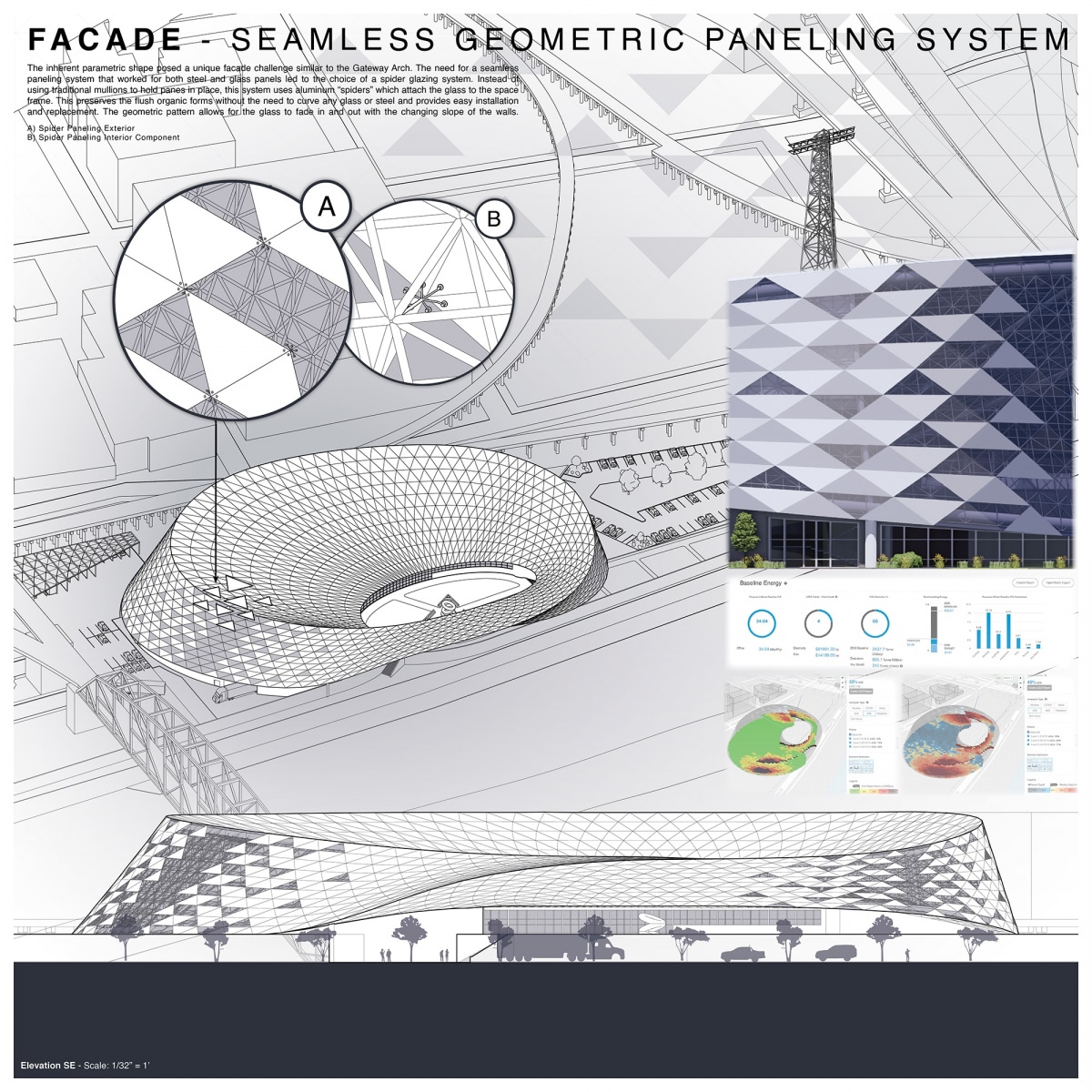
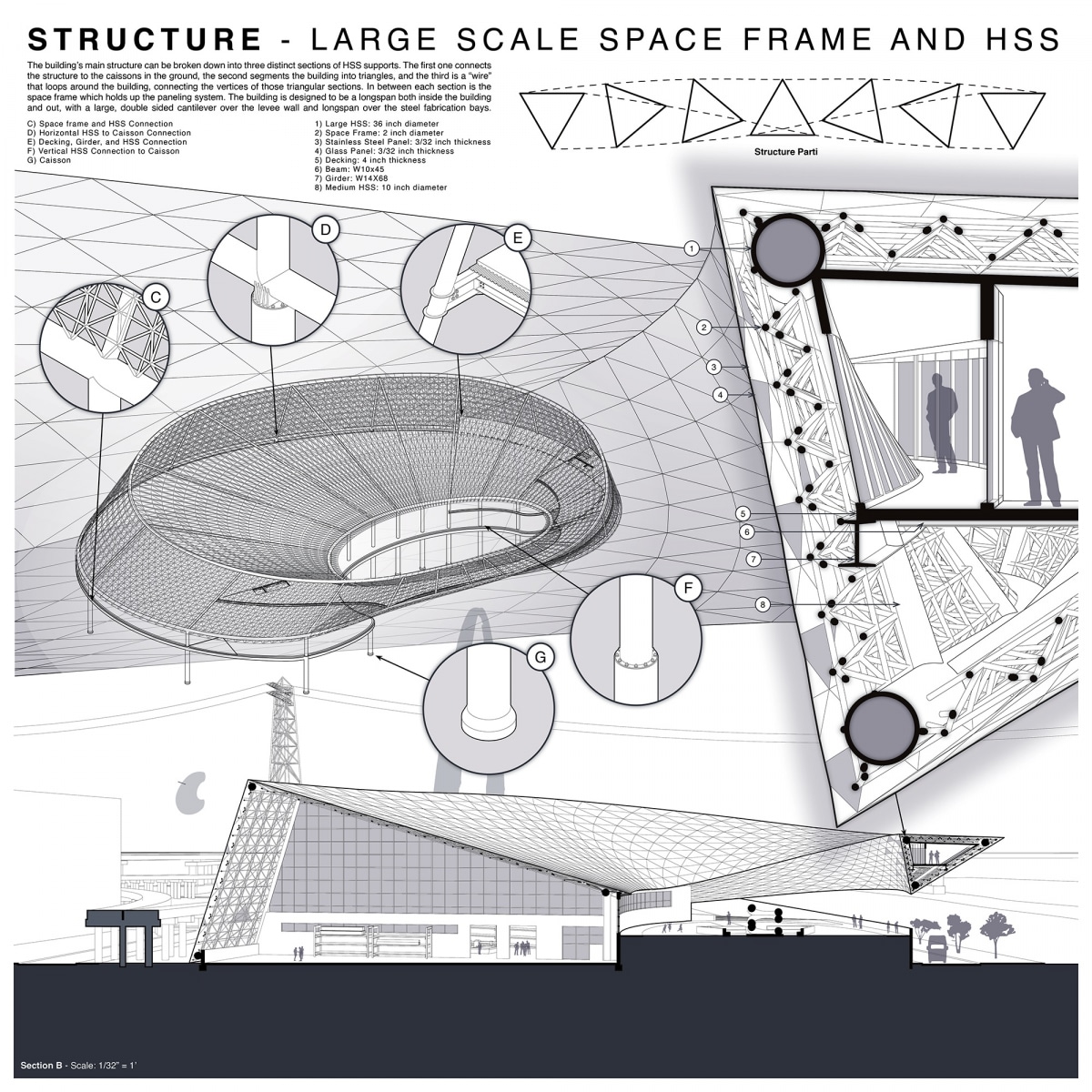
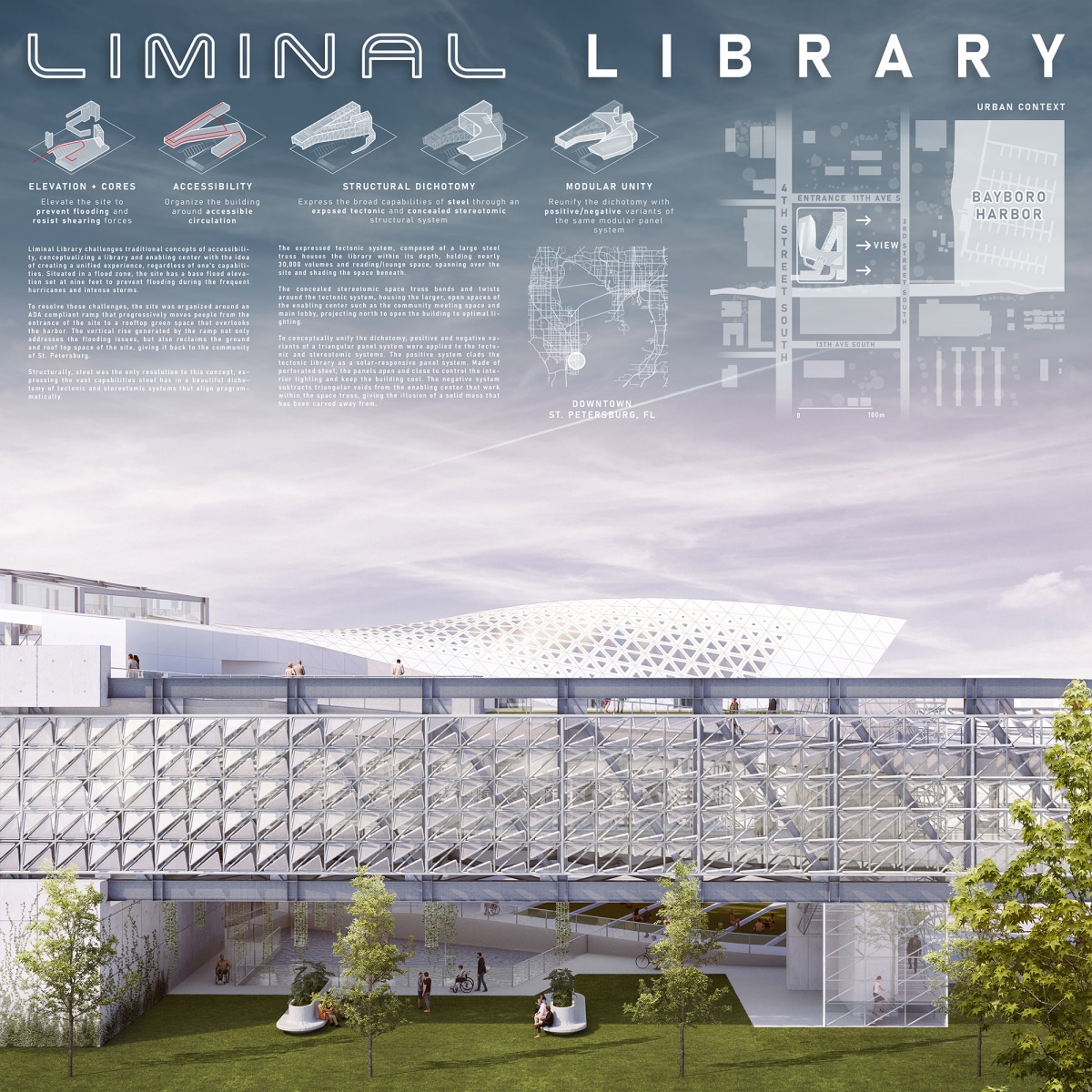

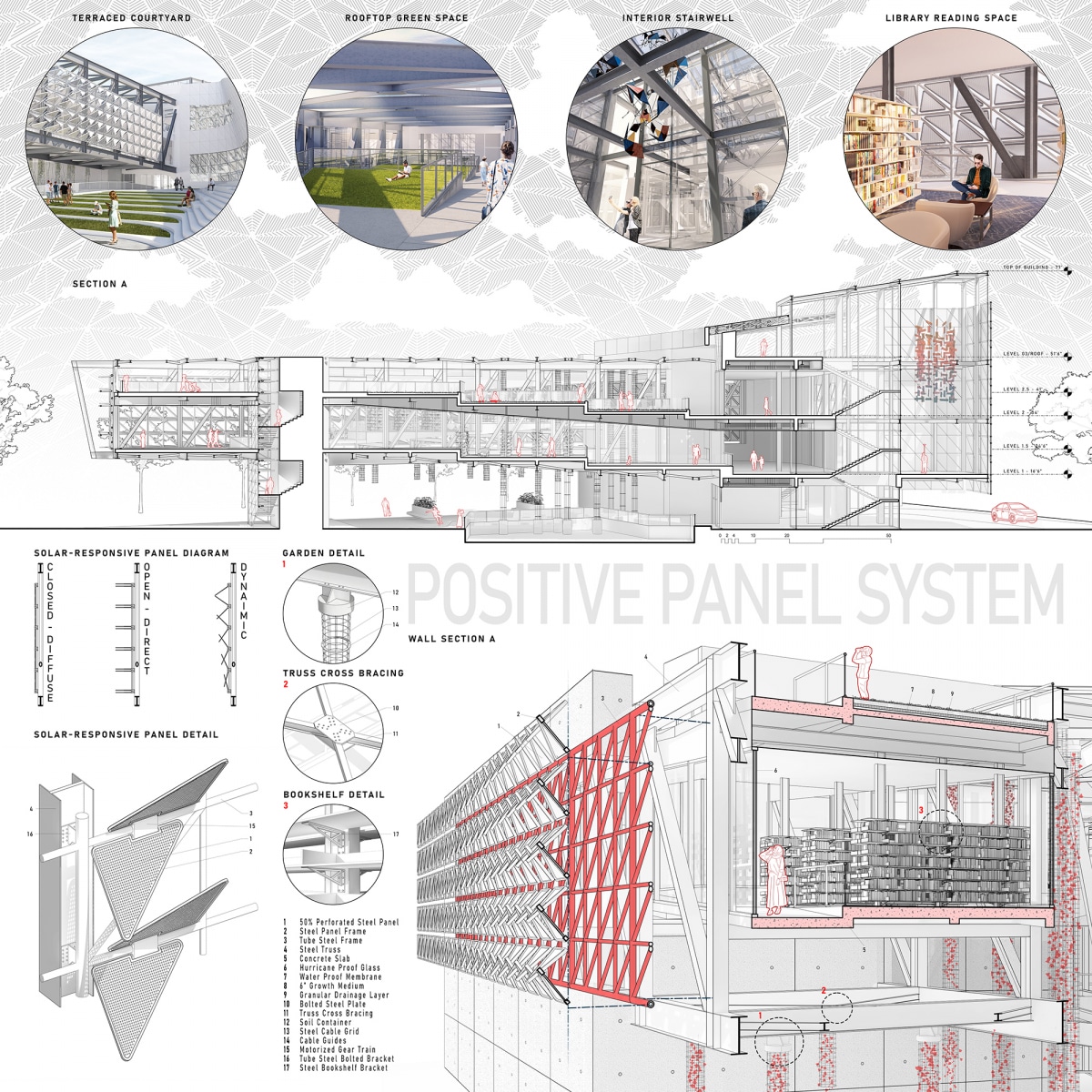

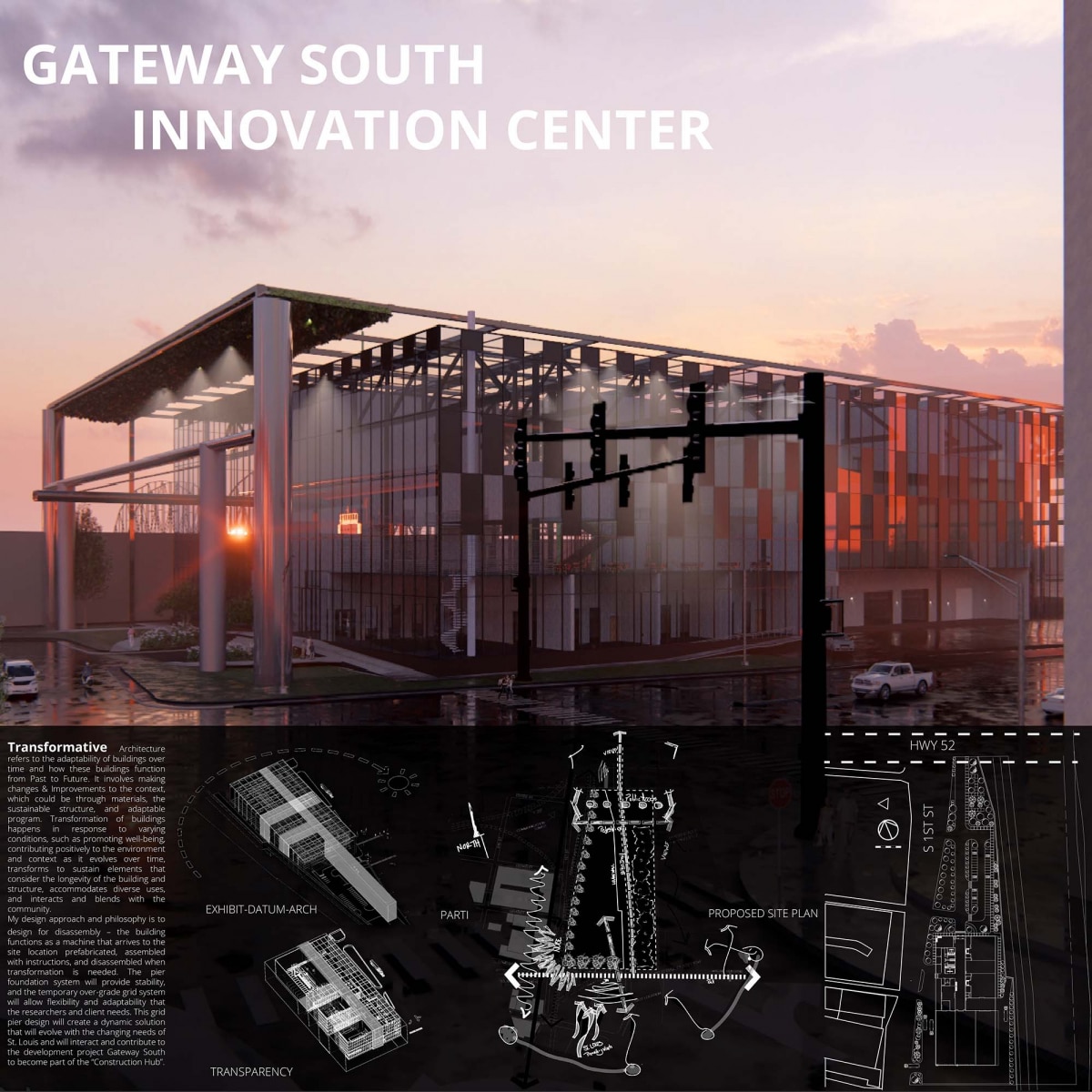
![board 2 [Recovered]2](https://www.acsa-arch.org/wp-content/uploads/2024/08/2024-Steel-Cat1-3rdPlace-012115-Gateway-Image2-Web-1200x1200.jpg)


